(Español) El ‘quiet luxury’ también se teje
The return of maximalism: unafraid to stand out
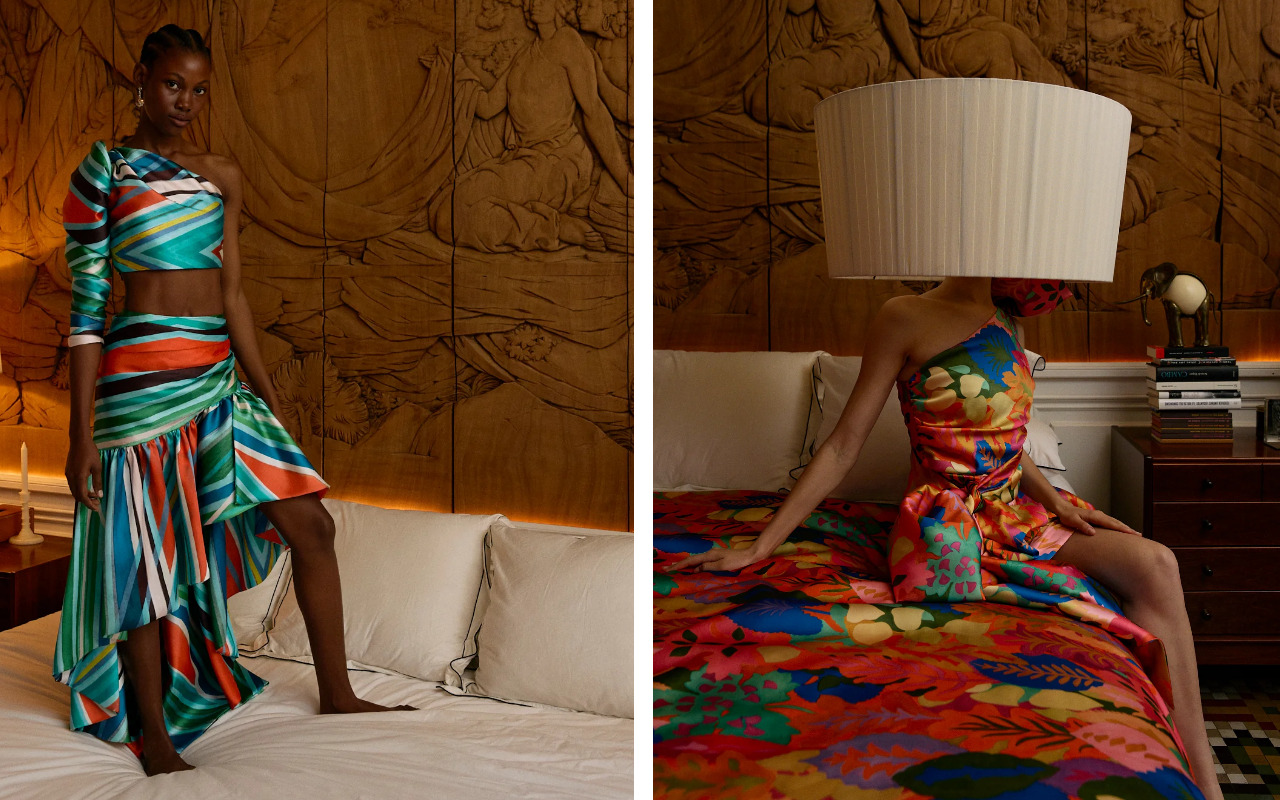 Collection 2025 Mariano Moreno
Collection 2025 Mariano Moreno
Fashion contradicts itself, and that’s part of its charm. Today we no longer live in linear cycles where one trend replaces the previous. Opposing styles coexist in the same season, broadening the creative spectrum. And that’s precisely what’s happening this summer. While the colour palette focuses on the softness of pastel tones and powdery hues, prints do just the opposite: they scream. They’re dressed in colour, energy, and excess.
Maximalism is making a strong comeback, taking over fabrics with a clear attitude: fearless, unfiltered, and without asking permission. And at Gratacós , where we’ve always celebrated contradictions as a creative starting point, we embrace it with enthusiasm.
2025 invites us to dream big. No discretion. Bold, vibrant, and artistically inspired prints become allies of designers, interior designers, and style lovers who shun the predictable. Monumental florals, abstract brushstrokes, unstable geometries, and lines of colour with a retro soul invade runways, salons, and streets with a new intensity.
It’s the era of the visual statement : dressing not just to be seen, but to speak volumes. Below, we review three major print trends that will define the SS25 season.
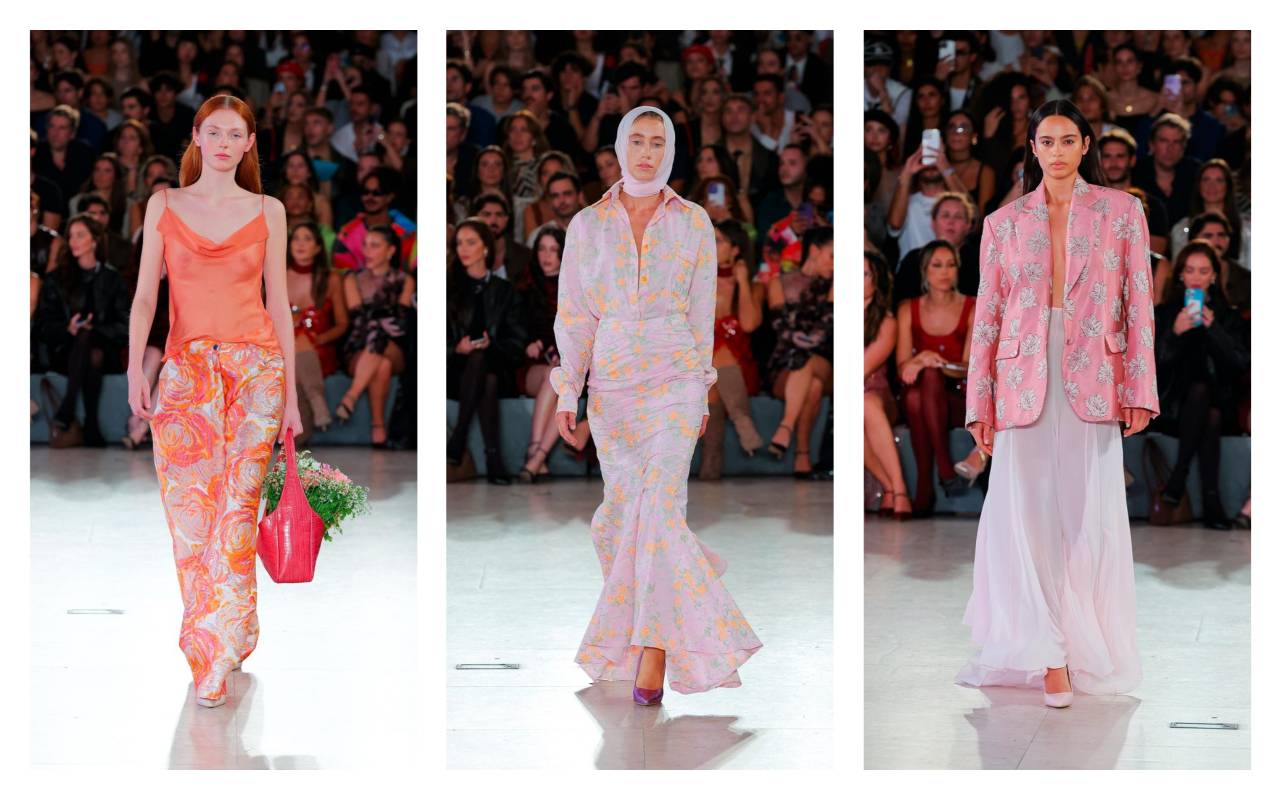 SS25 Gonçalo Peixoto
SS25 Gonçalo Peixoto
XXL Flowers: The garden overflows
This season, an exaggerated, wild, and profoundly contemporary botanical style flourishes. Floral motifs expand, distort, and reclaim their space with a visual exuberance that leaves no one indifferent. Think of artistically drawn peonies, saturated-hued hibiscus, or oversized tropical leaves: shapes that expand across the fabric as if alive, freed from any classic contours.
Ink stains merge with the background, contours drawn with expressive lines, overflowing watercolour effects, blurred shadows, black and white montages with colour accents, or compositions that look like they’ve come from a digital herbarium. Anything goes, as long as it’s bold, showy, and excessive. It’s a new floral language: more abstract than literal, more expressionist than decorative.
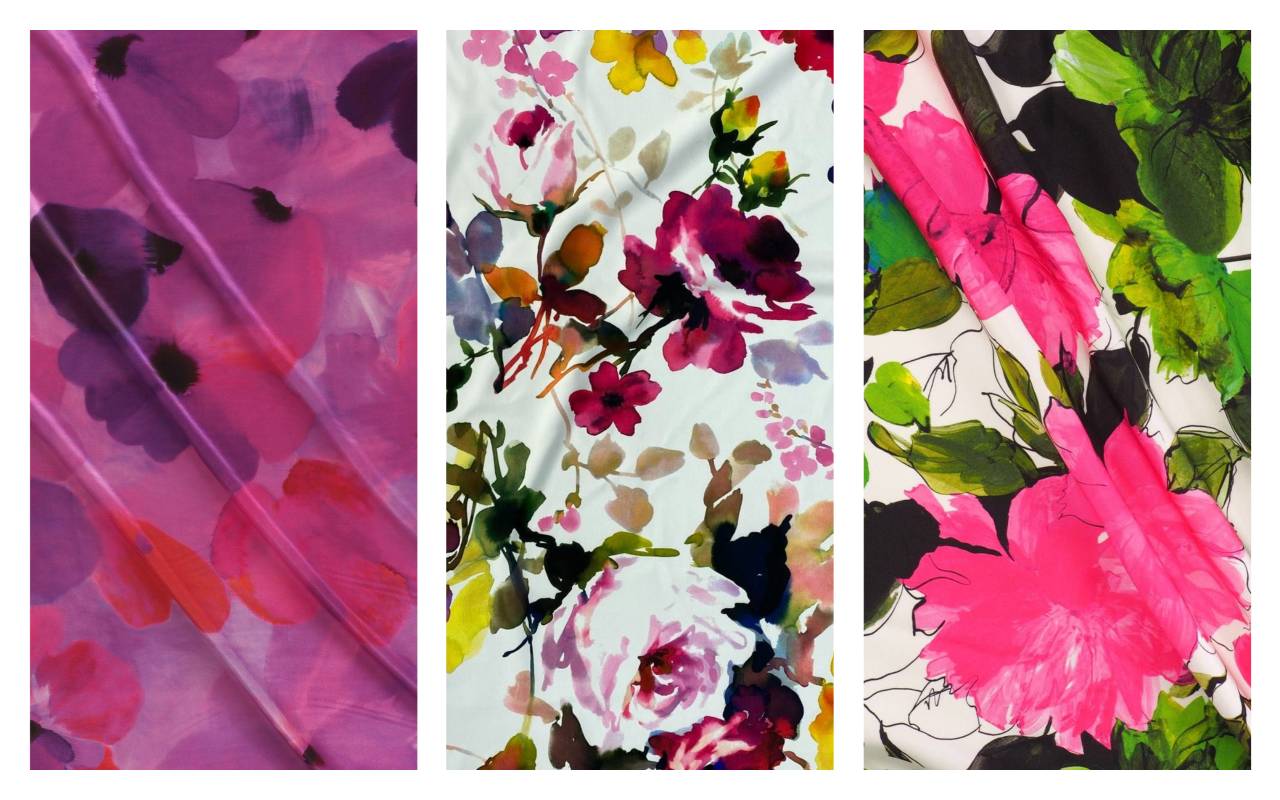
These prints find their best ally in fabrics with body and movement: gauzy organzas, satiny cottons, fluid silks, or embossed jacquards. Materials that allow colour to breathe, shapes to expand, and the garment to become a moving garden.
At Gratacós, this trend comes to life through large-scale floral fabrics with artistic prints and finishes that enhance the vibrant colours. Ideal for statement pieces that celebrate vitality, emotion, and unrestricted modernity.
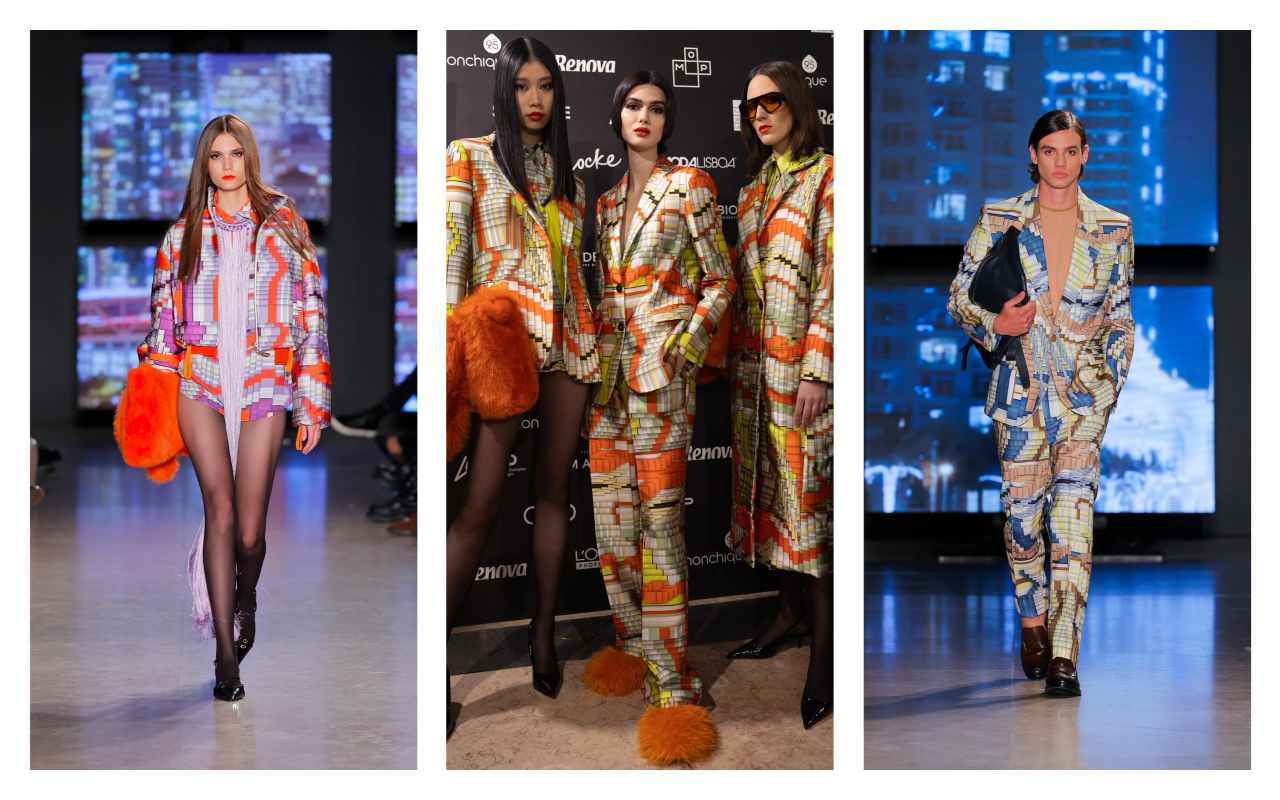 AW25/26 Carlos Gil
AW25/26 Carlos Gil
Abstract art and free geometry
Not every print needs a flower. Sometimes a gesture is enough. A loose stroke, a splash of colour, a line that curves or breaks. In 2025, fabrics become living canvases where abstraction and geometry come together to create compositions full of rhythm, texture, and emotion.
Spontaneous brushstrokes, watercolour splashes, shapes reminiscent of action. Painting or sketchbook graphics: print art abandons figuration to focus on gestures. This trend coexists with another trend that is gaining strength: irregular and graphic geometries, as if drawn freehand. Imperfect grids, repetitive blocks interrupted by voids, floating dots, circular connections, or divisions that decisively break classical harmony.
The result is a new generation of prints where visual emotion replaces ornament. A balance between the technical and the poetic, between mathematical structure and deliberate imperfection.
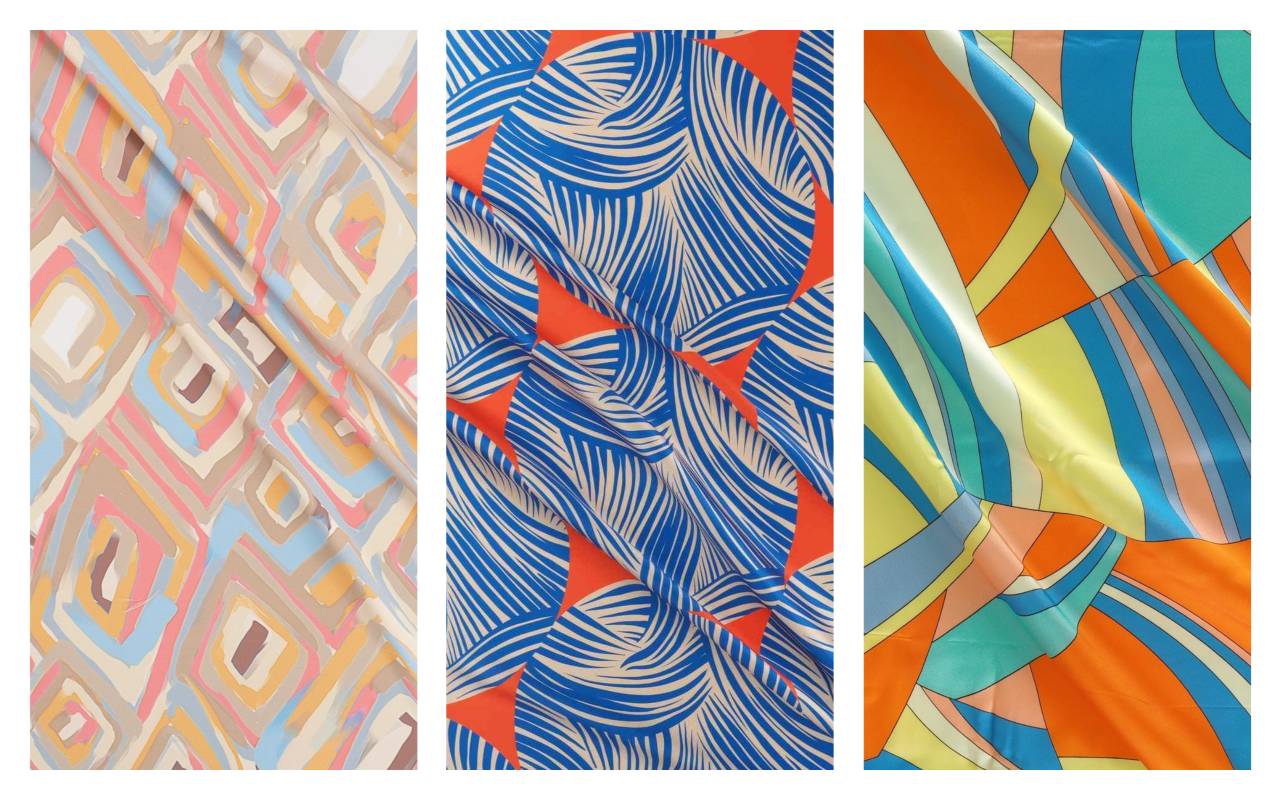
These prints work especially well on fabrics that allow the design to flow: soft twills, drapey crepes, full-bodied viscose fabrics, or satin silks where the colour vibrates more deeply. They’re perfect for flowing garments, statement shirts, or loose-fitting pants that move with their own flow.
At Gratacós , this trend translates into fabrics with abstract prints and contemporary graphics that appear hand-painted or structured with imperfect precision. These designs stimulate creativity and allow you to play with pattern as a starting point for a distinct visual story.
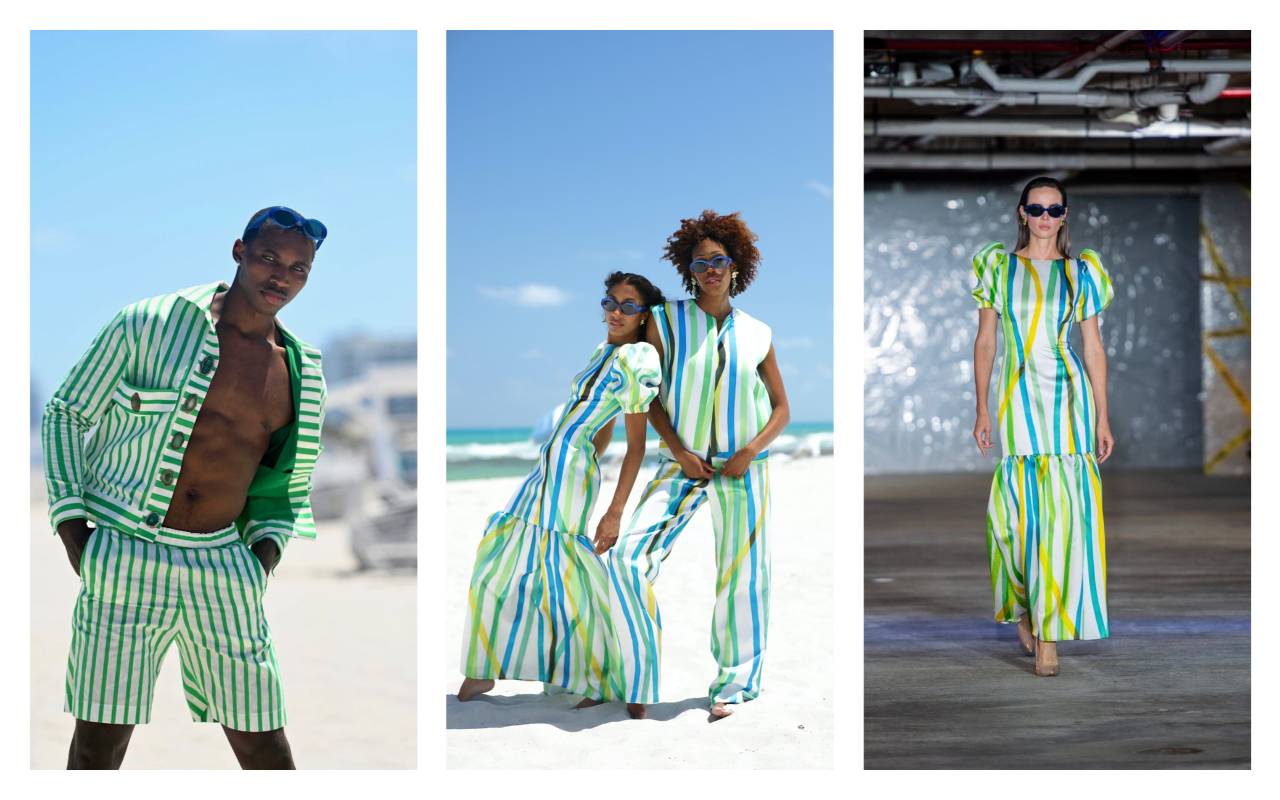 SS25 Mariano Moreno
SS25 Mariano Moreno
Stripes, nostalgia and graphic pop: the most vibrant revival
Stripes have never been around, but in 2025 they’re back with a new visual energy. They’re no longer discreet or sober. Now they’re widening, curving, and crisscrossing. They’re dressed in vibrant colours, overlapping fearlessly, drawing inspiration from the aesthetics of the 60s and 70s and blending with influences from contemporary graphic design.
This revival brings with it a visual joy that is expressed through candy Stripes , acidic palettes, deliberately clashing colour combinations, abstract lines that blur in motion, or compositions reminiscent of industrial graphic art. Motifs that look like they’ve been taken from a beach blanket, a circus tent, or a pop silkscreen poster.
The visual impact is immediate, but also structural. These stripes act as a reading direction: they lengthen, widen, or redraw the silhouette. In some cases, they even generate optical effects that merge body and pattern into a single visual architecture.
The ideal fabrics for this trend are those that offer crisp lines and rich colour saturation: technical cottons, multicoloured jacquards, structured poplins, or graphic satins that combine body and shine. There are also more relaxed versions in linens or rayons, perfect for summer garments with personality.
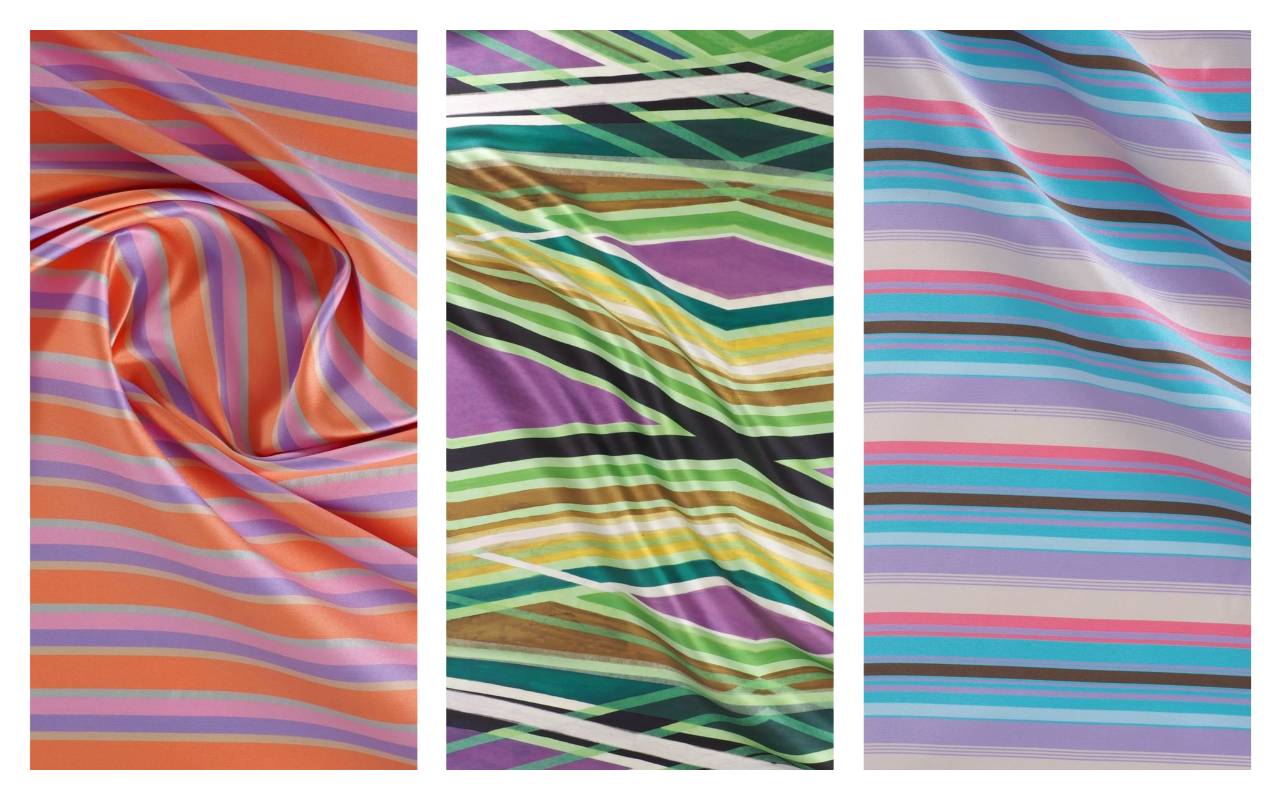
At Gratacós, this trend is embodied in striped fabrics with a vintage feel and colour combinations that play with harmony and contrast. A meeting point between nostalgia and contemporary design, designed for designers seeking rhythm, character, and their own graphic style.
In a summer where prints take centre stage, florals explode, lines create new narratives, and retro graphics make a strong comeback, fabrics become a tool for limitless expression. Because if this season reminds us of anything, it’s that dressing—and creating—is also a way of taking a stand.
Welcome to a summer that’s anything but boring!
David Bower: Under Sikitas lens
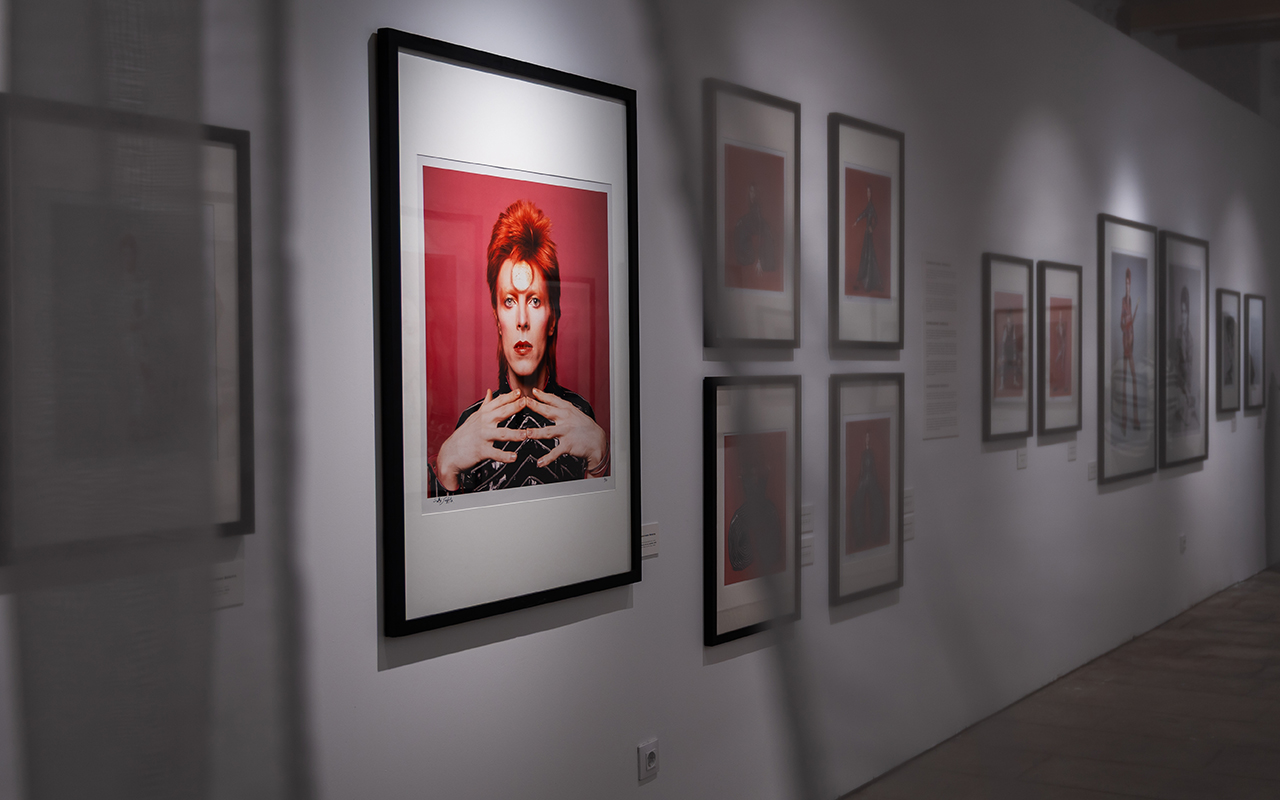
Bowie & Sukita Exhibition at Fotonostrum Gallery
There are artists who change their skin. David Bowie collected them all. Beyond his musical legacy, his image was a constantly evolving work of art. His wardrobe was his armor, his manifesto, his mirror. And photography, the medium that immortalized each transformation. The Bowie x Sukita exhibition, which can be visited at the FotoNostrum gallery in Barcelona until 15th September, invites you to immerse yourself in this chameleon-like universe through more than 70 iconic images captured by Japanese photographer Masayoshi. Sukita , one of the great witnesses of his metamorphosis.
Curated by the Italian group Ono Arte, this intimate and visual exhibition draws a direct line between Bowie’s aesthetic and his artistic restlessness. From his beginnings as Ziggy From Stardust in the 1970s to his later years, each selected image reveals a new incarnation of the artist. Sukita ‘s lens remains with him for more than four decades: she observes him, understands him, follows him. And in return, Bowie offers her more than just poses. He gives her a developing persona that metamorphoses at each stage and, without the need for words— Sukita didn’t speak English—builds a profound bond between artists.
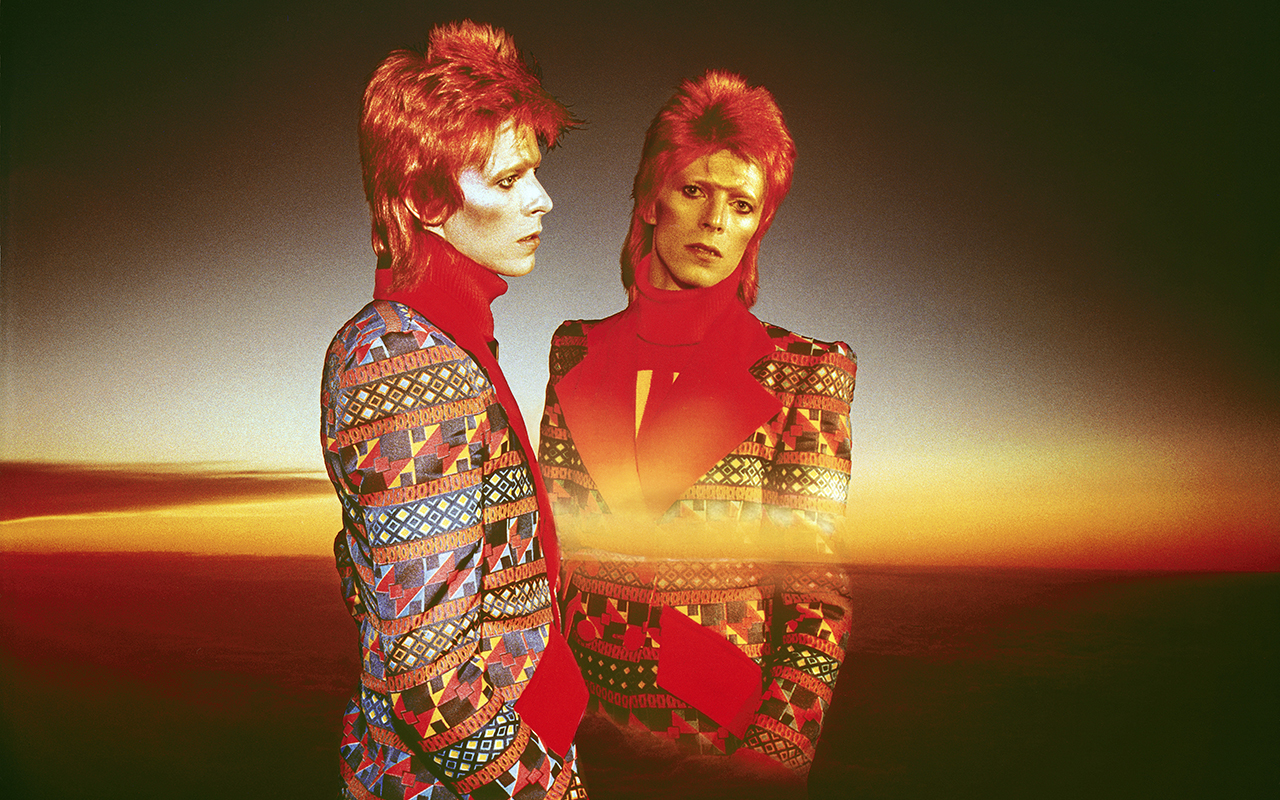
Down of Hope, 1973 © Photo by Sukita
A relationship sealed by the image
Their first contact arose sporadically in London in 1972, when Sukita traveled from Japan to photograph Marc Bolan of T-Rex and ended up meeting Bowie at one of his concerts. That first meeting marked the beginning of a sustained collaboration, which would give rise to one of the most recognizable images of the 20th century: the cover of the album Heroes (1977). But beyond this graphic icon, what emerges in this exhibition is the complicity between two creators who understand each other through intuition and silence.
In the images, we see Bowie as we knew him—radical, provocative, ethereal—and also as we’ve never seen him before: serene, introspective, almost domestic. The exhibition also includes lesser-known photographs taken in Japan, a country that inspired the artist with its refined aesthetic, symbolic theatricality, and visual culture. These scenes exude a different calm, a more deliberate Bowie, but just as magnetic.
Costume as a narrative
Bowie never dressed casually. Each outfit was a statement of intent. His wardrobe oscillated between futurism and nostalgia, androgyny and exaggeration, craftsmanship and artifice. In these photographs, fashion ceases to be decoration and becomes visual text: a metallic latex jumpsuit, a military-inspired suit, a geometric ensemble with oriental reminiscences… The fabrics that envelop him tell stories without words.
Extreme silhouettes, shiny textures, impossible collars, gravity-defying sleeves. The choice of materials—patent leather, lurex , velvet, lamé —constructed a silent choreography that dialogued with the music and the gesture. Bowie understood that a suit could sing on its own, and that a clothed body was also a clothed idea.
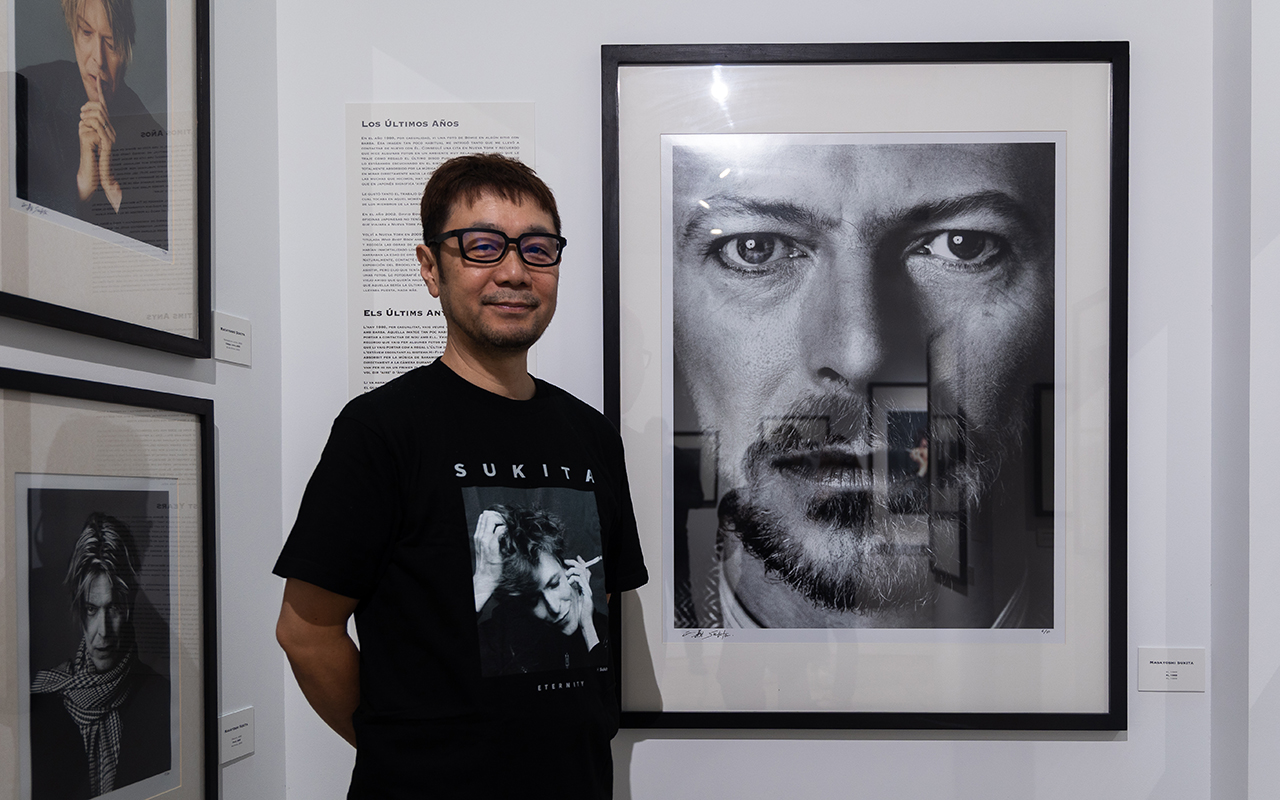
Aki Sukita, nephew of the renowned Japanese photographer, at the gallery. Pic by Fotonostrum
Sukita : the eye that intuited the myth
Masayoshi Sukita, born in Japan in 1938, came from the world of men’s fashion photography. His eye was trained to detect gestures, details, silences. Fascinated by urban subcultures and psychedelic rock, se attended Woodstock and photographed artists such as Iggy Pop, Joe Strummer , Devo , and YMO. But it was with Bowie that he found a true dialogue.
Sukita didn’t seek to capture the obvious, but the invisible. His mastery of composition, light, and scenic balance allowed him to create atmospheric, almost cinematic portraits. Many of the images that are now part of the collective imagination are born from this artistic bond and a trust forged over time.
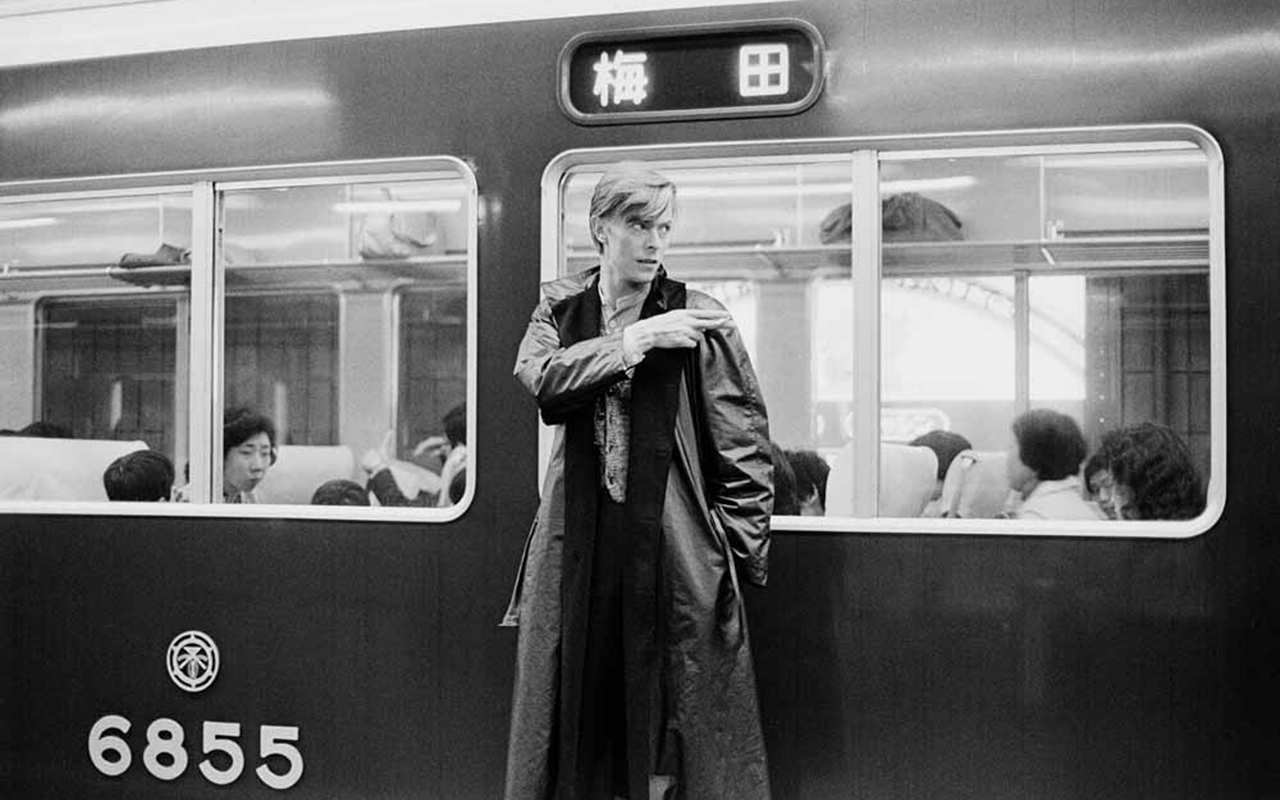
A Day in Kyoto 6 – Departure, 1980 © Photo by Sukita
A journey through style as freedom
Visiting Bowie x Sukita is like immersing yourself in an emotional archive where photography and fashion interact without hierarchy. There are intimate portraits, staged sessions, and concert photographs that capture the electricity of live performance. Each snapshot is an open door to the universe of an artist who made his body a canvas and his wardrobe a manifesto.
Today, designers, artists, and textile lovers continue to draw on his legacy. Because Bowie didn’t just dictate trends: he shattered them. He was haute couture without a runway, glam without gender, avant-garde without nostalgia. And that free, brave, and deeply visual spirit connects with the soul of Gratacós, where each fabric is also a creative act.
Practical information
📍 Bowie x Sukita
From May 23 to September 15, 2025
FotoNostrum – Carrer Princesa 19, Barcelona
www.fotonostrum.com
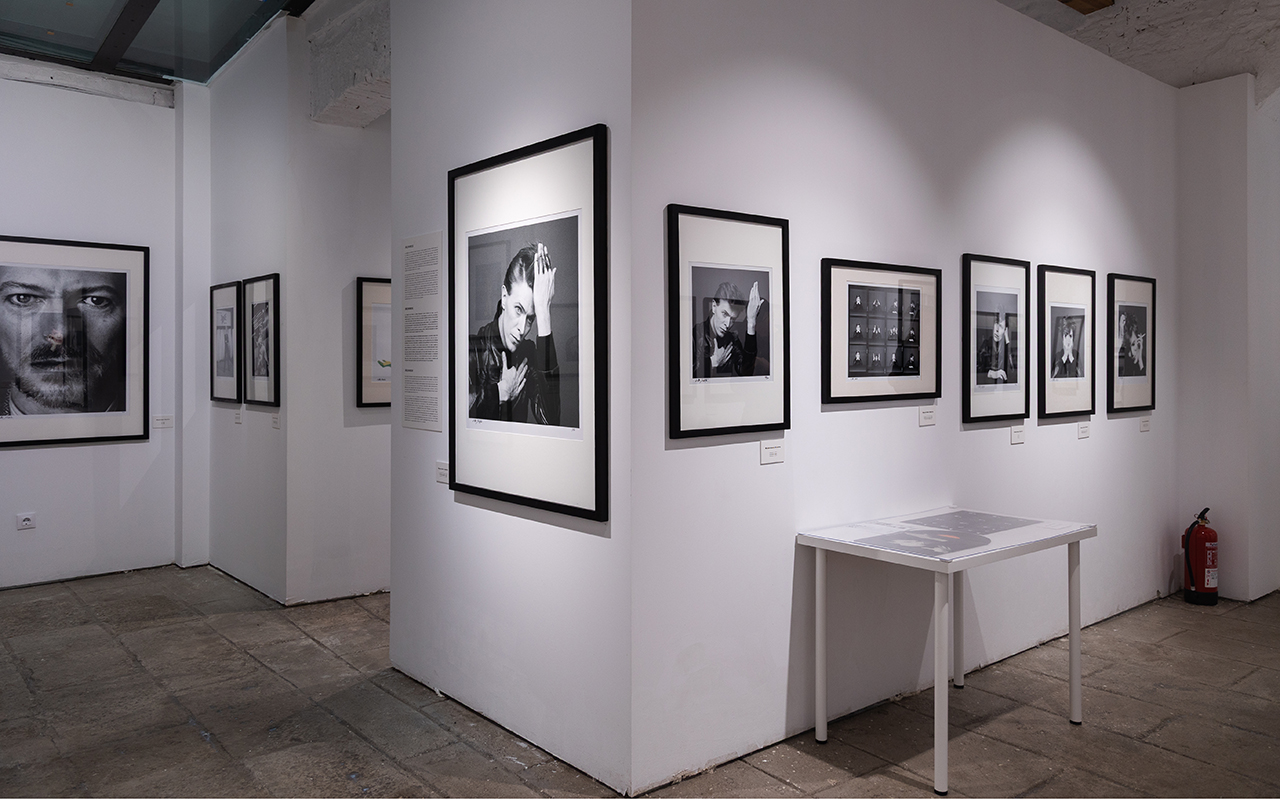
Everything you didn’t know about butter yellow
 Butter yellow inspirational collage. Photo by Mariano Moreno
Butter yellow inspirational collage. Photo by Mariano Moreno
Spring is blooming in all its splendor, and among the array of colours inspired by this chromatic renaissance, one stands out above the rest in 2025. Whether due to trend, taste, or natural predilection.
A colour that doesn’t shout. That doesn’t need to impose itself to be memorable. This season, yellow tones down to cream. It becomes buttery. A shade that illuminates without being too loud and glides smoothly over lightweight fabrics like organza, silk, and cotton.
Far from seeking prominence, butter yellow accompanies, soothes, and nuances. In a time when everything vibrates to the rhythm of the fleeting, this shade reappears as a nod to comfort, tenderness, and a quieter elegance. Once considered difficult, even feared, it now sneaks into refined collections, runways, and editorials as the preferred shade for those seeking a balance between the romantic and the contemporary.
We discover some of its many facets.
 Butter yellow inspirational collage. Photo by Gonçalo Peixoto
Butter yellow inspirational collage. Photo by Gonçalo Peixoto
A Brief History of Yellow: From Noble to Marginal
Yellow is one of the oldest and most symbolically charged colours in the history of art and clothing. Found in the natural pigments of Ancient Egypt—where it was associated with gold, the sun, and eternity—it was also one of the most widely used shades in Roman and Byzantine frescoes for its ability to capture light.
For centuries, however, yellow lived in a constant duality: on the one hand, it represented light, energy, and nobility; on the other, it was stigmatized by its association with betrayal or marginality in certain historical contexts. In the Middle Ages, for example, it was the colour imposed on heretics and the marginalized. This chromatic ambivalence has carried over into modern times, leading yellow to be considered for decades a difficult, even “cursed” shade, especially in fashion.
Since the 20th century, with the explosion of modern design, the colour has regained its place as a symbol of avant-garde and provocation. From the neon yellow of the 1980s to the mustard of the 1970s to the fluorescent yellow of the 2000s, this shade has shifted its meaning with each generation.
Today, in its softest and creamiest version, butter yellow presents itself as a natural evolution: a meeting point between sophistication and warmth, between warmth and neutrality. It’s the yellow that leaves drama behind to become balanced.
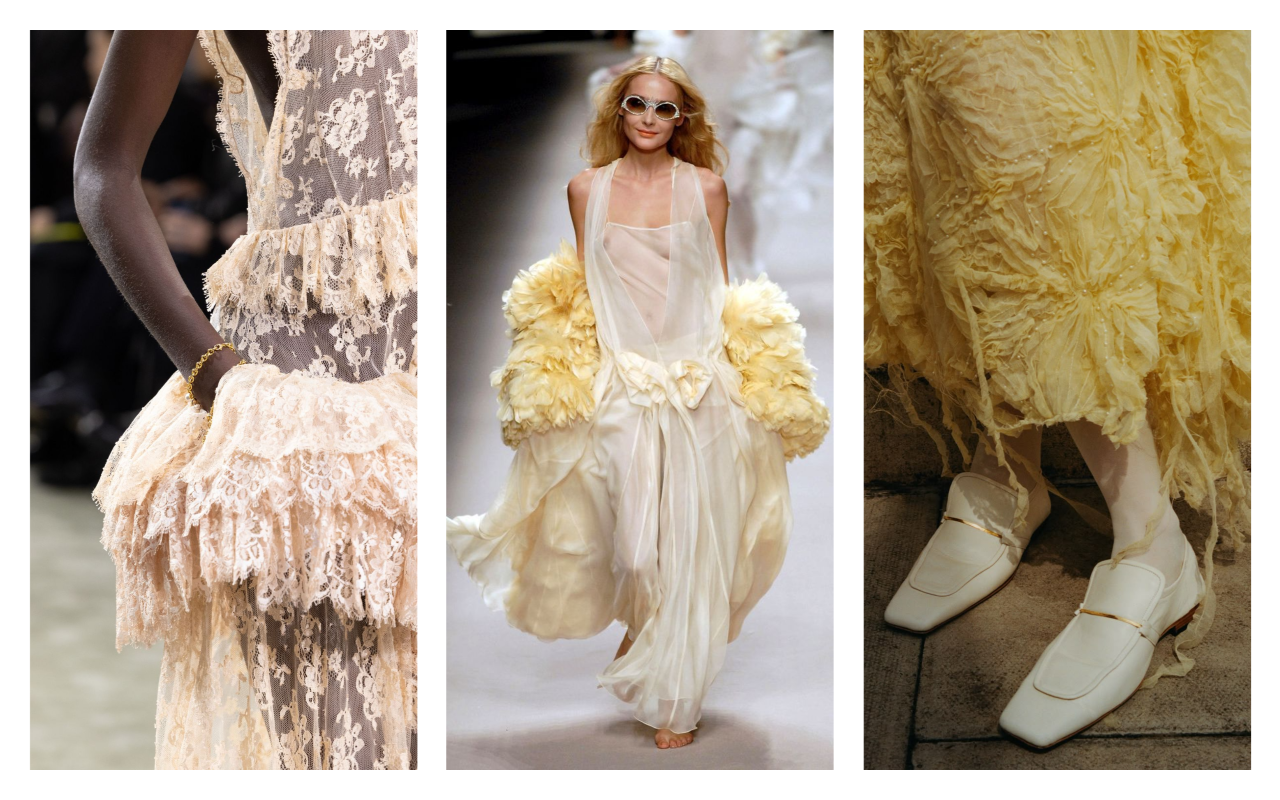 Butter yellow inspirational collage. Photo by Pinterest.
Butter yellow inspirational collage. Photo by Pinterest.
Why does this burst of butter yellow reach us?
In a world where trends change at the speed of a scroll And everything coexists with everything else, so talking about “colour trends” may seem anachronistic. However, there are shades that capture the emotional pulse of an era. Butter yellow is one of them.
This soft, approachable, and unpretentious hue connects with a collective desire for calm, well-being, and aesthetic refuge. In the face of excess, visual overload, and the chromatic noise of digital technology, colours emerge that invite us to slow down. Pastel yellow—specifically, this creamy and luminous version—is perceived as a visual balm. A microtrend that seeps into fashion, interior design, cosmetics, and even the digital world.
Colour psychology associates yellow with creativity, vitality, and optimism. In its softer form, this energy is nuanced and becomes something more introspective: tenderness, sensitivity, kindness. It’s a colour that doesn’t impose, but rather accompanies.
In a context where the ephemeral prevails but human beings continue to search for meaning, butter yellow represents an aesthetic response to an emotional need: returning to the essential, but with light.
 Catwalks SS25 Chloé, Chanel and Toteme.Butter yellow inspirational collage. Photo by Pinterest
Catwalks SS25 Chloé, Chanel and Toteme.Butter yellow inspirational collage. Photo by Pinterest
From the catwalk to a global phenomenon
Butter yellow has gone from being a chromatic curiosity to becoming one of the most visible—and desirable—colours of the season. This spring/summer, its presence on runways, red carpets, and editorials has confirmed what the trends had already suggested. insiders : we are facing a new neutral.
It all started with a resounding gesture: Timothée Chalamet appeared on the Oscars red carpet in a butter yellow ensemble, breaking new ground and generating headlines. A few days later, Katie Holmes wore it elegantly to the Zimmermann show, pairing a trench coat and trousers in this shade with black and chocolate brown accessories . style immediately embraced it, leaving us with monochromatic styles and combinations with beige, off-white and earth tones that have multiplied its versatility.
On the catwalk, brands such as Givenchy, Bottega Veneta , Molly Goddard, Zimmermann, Christopher Esber either Rotate has dyed their collections this creamy shade. In Sarah Burton’s debut collection for Givenchy, a coat with pronounced shoulders and a cinched waist became one of the season’s most viral pieces. Meanwhile, Toteme presented scarf dresses, shawls, and minimalist blouses that bring this colour closer to the Scandinavian universe.
What’s interesting is how this shade adapts to all types of garments. From the most romantic midi and maxi dresses to structured suits, nappa leather jackets, silk blouses, or even denim outfits . Row and Jacquemus has reinterpreted it from two opposing but equally sophisticated perspectives: one more refined and urban, the other more sensual and Mediterranean.
What was once perceived as a “difficult” shade is now positioned as a new wardrobe staple. A colour that doesn’t seek to set a trend, but rather to maintain its place.
A colour rich in nuances
If there’s one place where butter yellow truly unleashes its potential, it’s in fabric. Its chromatic softness demands materials capable of delicately reflecting light, without losing body or definition. It’s a colour that doesn’t tolerate flatness: it requires textures, nuances, and structures that make it vibrate with every movement.
In drapey fabrics—such as satin silk, crepe, cotton voile , or embroidered tulle—it takes on an ethereal air, perfect for ceremony dresses, flowing pieces, or signature shirts. In more technical bases like mikado, taffeta, or lightweight nappa leather, it gains strength and sophistication, ideal for structured suits, capes, or details with sculptural volume.
Butter yellow also works surprisingly well in textured fabrics: floral jacquards, tonal embroidery, subtle lace, even in versions with an iridescent or dry sheen effect, providing richness without being too strident.
At Gratacós we interpret it as a colour that doesn’t need to raise its voice to be noticed. It connects with honest design, with a personal perspective, and with sensitivity in the choice of materials.
And if you’re looking for inspiration…
Explore our selection of butter yellow fabrics in our online store: designs that combine softness, sophistication, and character to create timeless pieces with a contemporary soul. Because sometimes, the power of colour lies precisely in its delicacy.
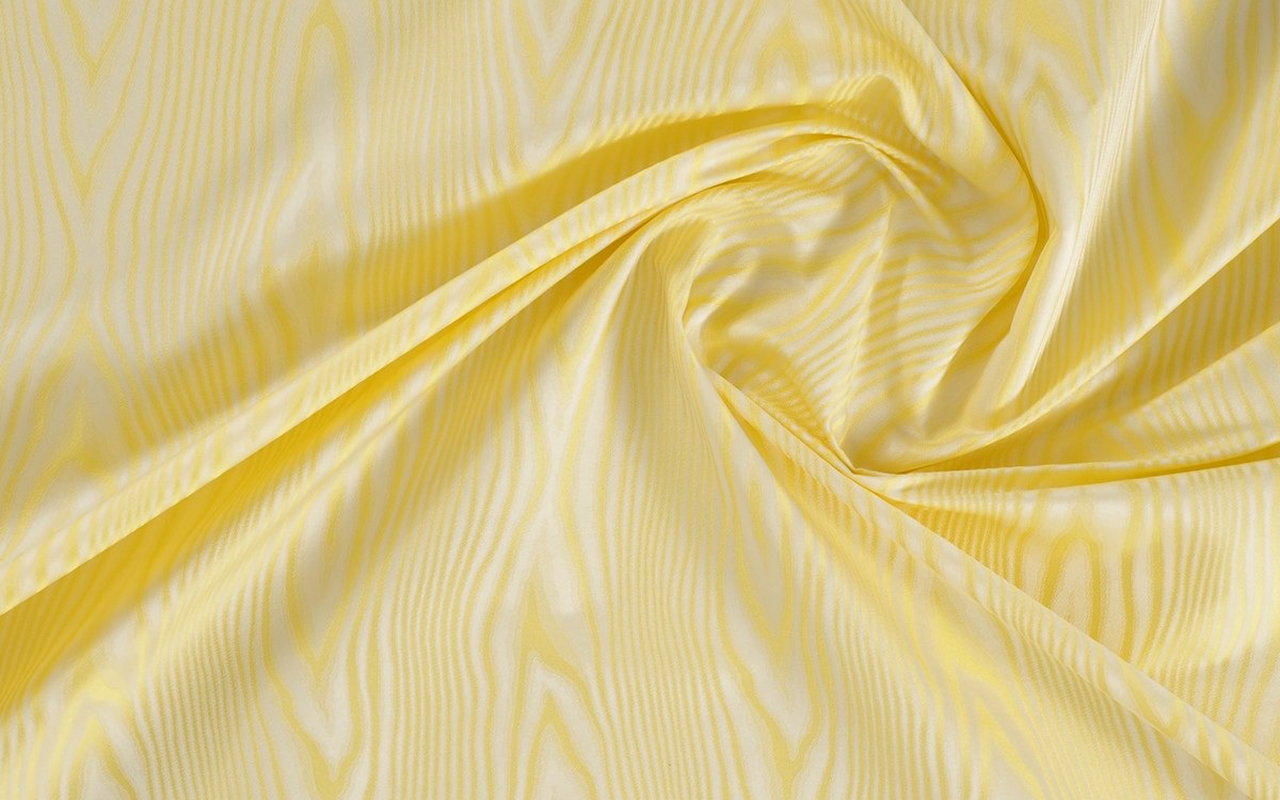
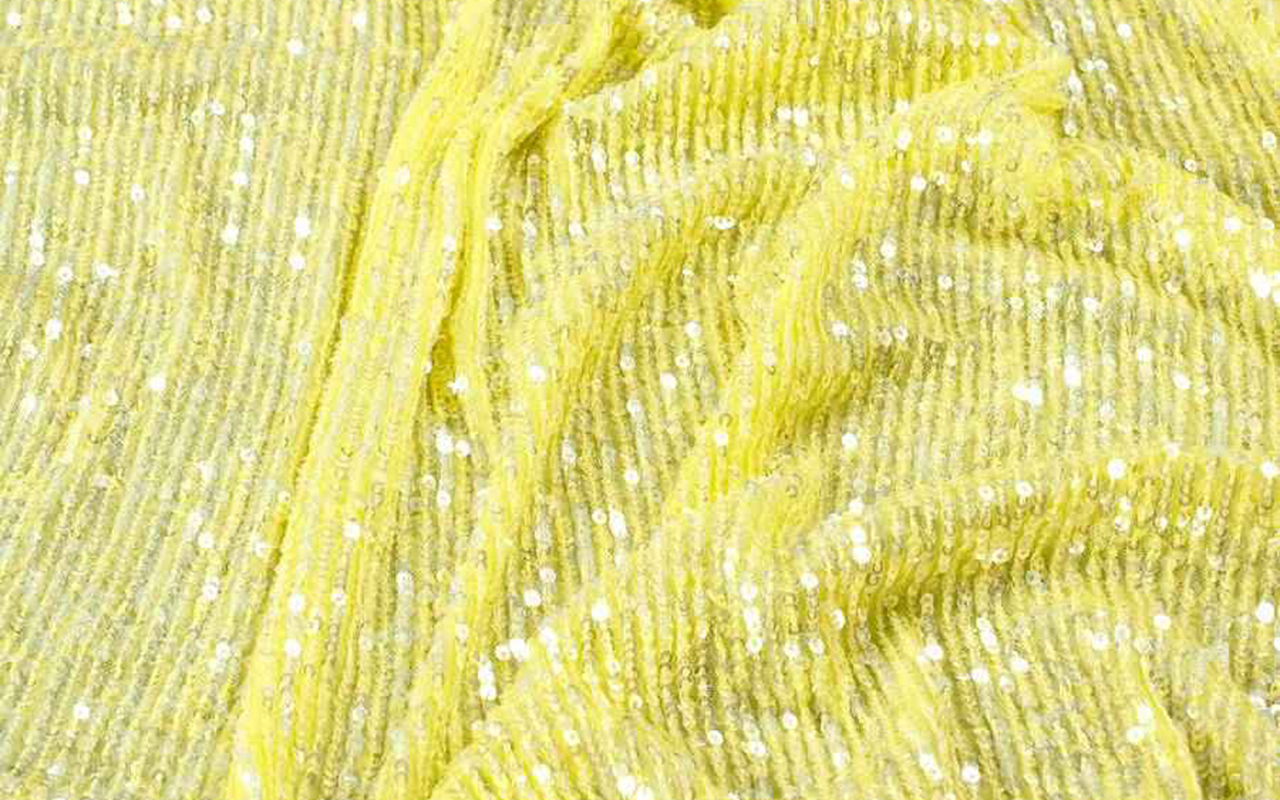
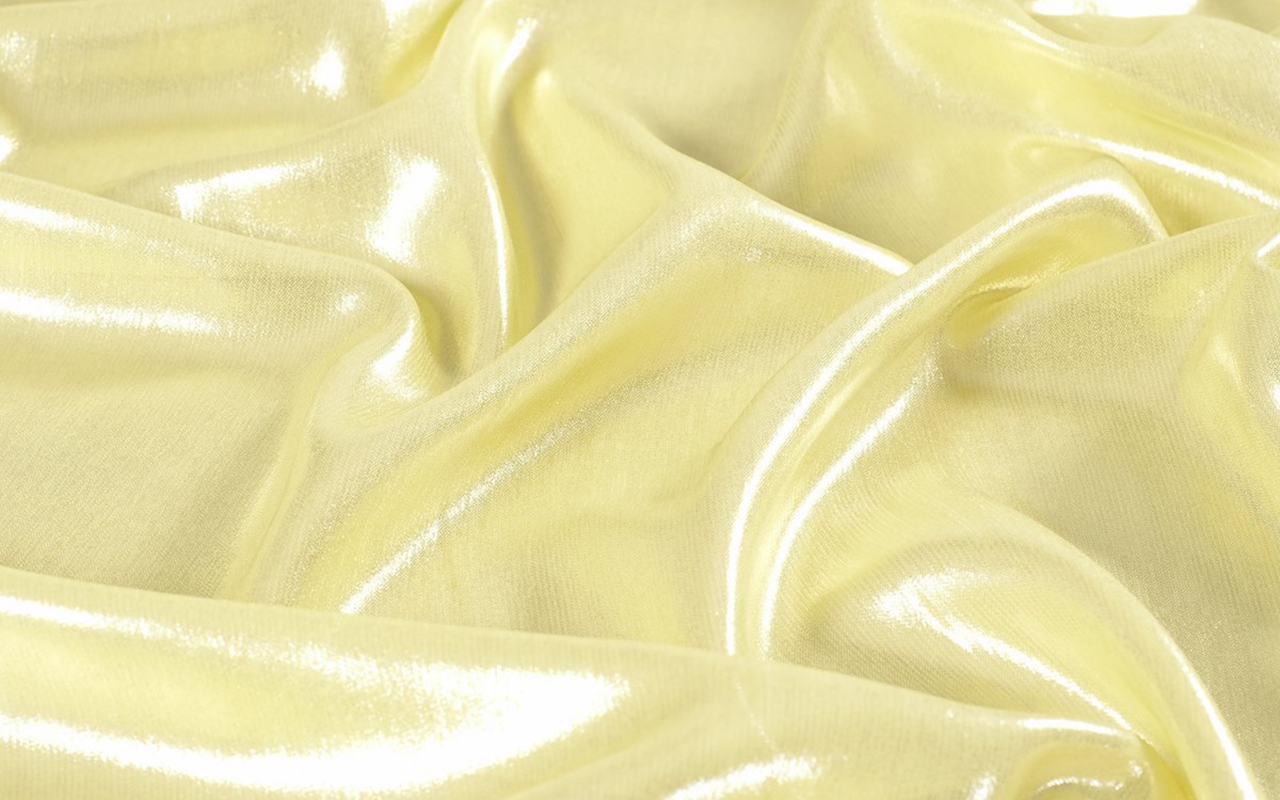
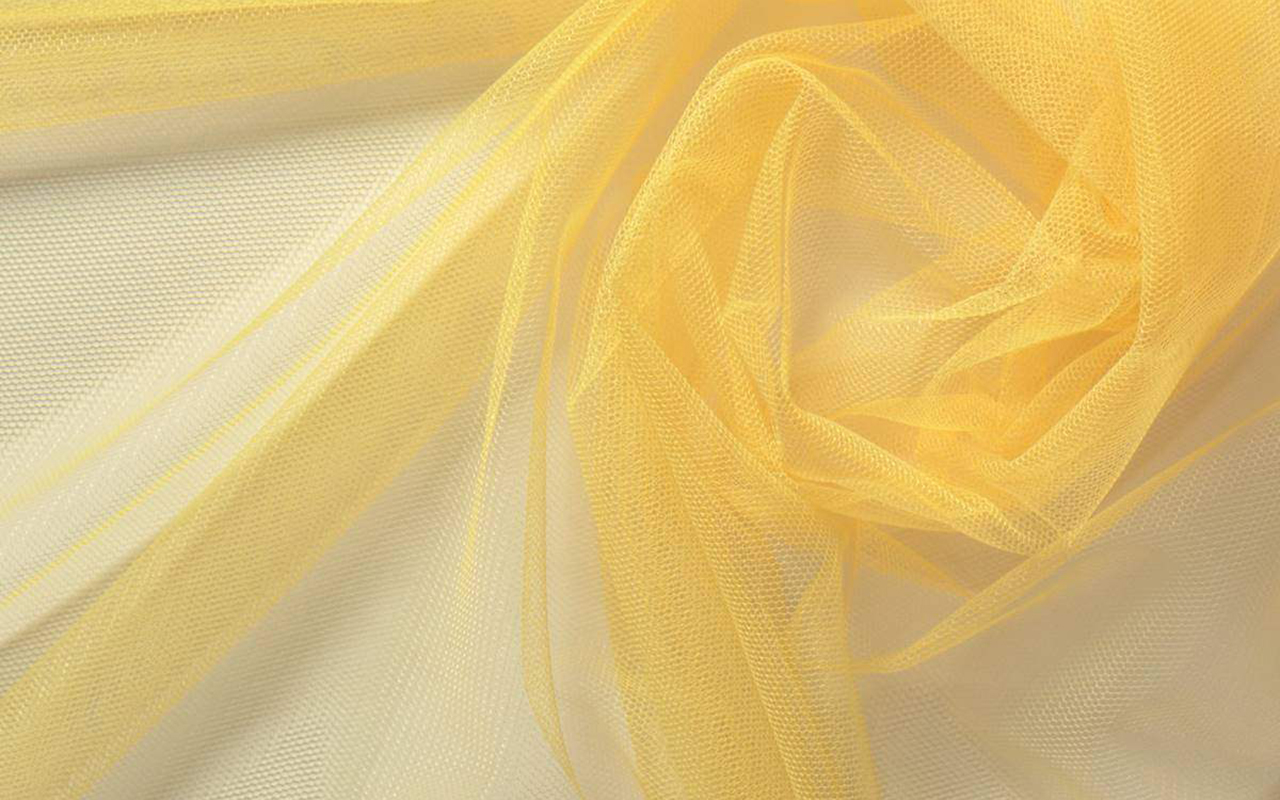
A global showcase of bridal fashion. Barcelona Bridal Week 2025
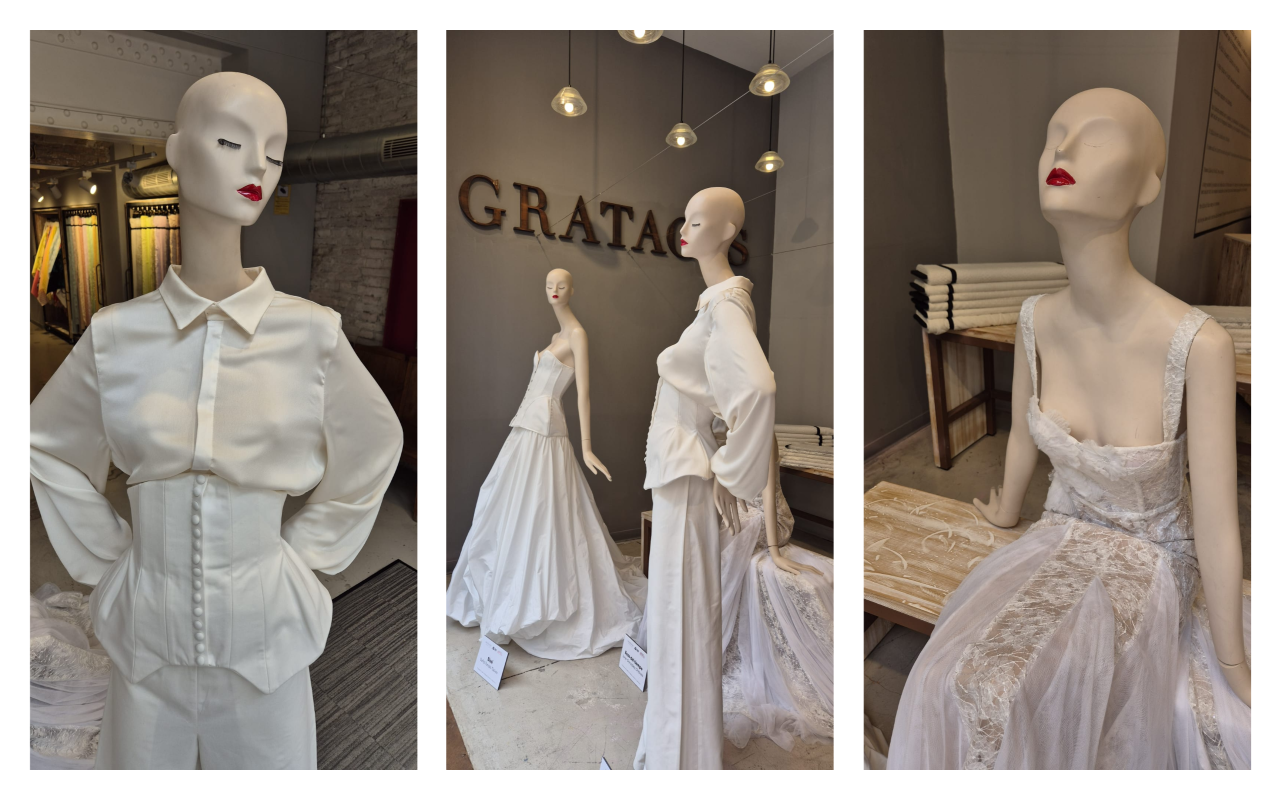
April bids farewell in white to a month dedicated to bridal tradition. From our showcase, once again dedicated to the technique of moulage through three designs created by students of the postgraduate course in wedding and ceremony dress design at IED Barcelona, to our special corner for brides, everything at Gratacós was filled with bridal spirit. The dreams of future brides- to- be and those who wanted to relive their stage presence were also tingued in white, without missing a single detail of the new edition of Barcelona Bridal Fashion Week 2025. A showcase of international relevance that once again demonstrates that bridal fashion is not just an act of creation: it is also a language that speaks of desire, beauty, and new possibilities.
This historic edition, the largest held to date, annually transforms Barcelona into the global epicenter of bridal art . A space where established designers, independent ateliers , and new voices reimagine the wedding dress as an intimate expression of identity, sensitivity, and future. More than 40 fashion shows, a vibrant showroom, and a stage that exudes innovation, craftsmanship, and emotion. Every stitch, every lace, every volume that paraded on Montjuïc is an invitation to dream anew, to understand that true modernity lies in the connection between hands, material, and imagination.
At Gratacós, we draw inspiration from this universe of textures, volumes, and details that tell stories of love, but also of evolution, strength, and timeless beauty. Below, we analyze some of the shows we attended personally to highlight the trends we’ve seen for brides-to-be.
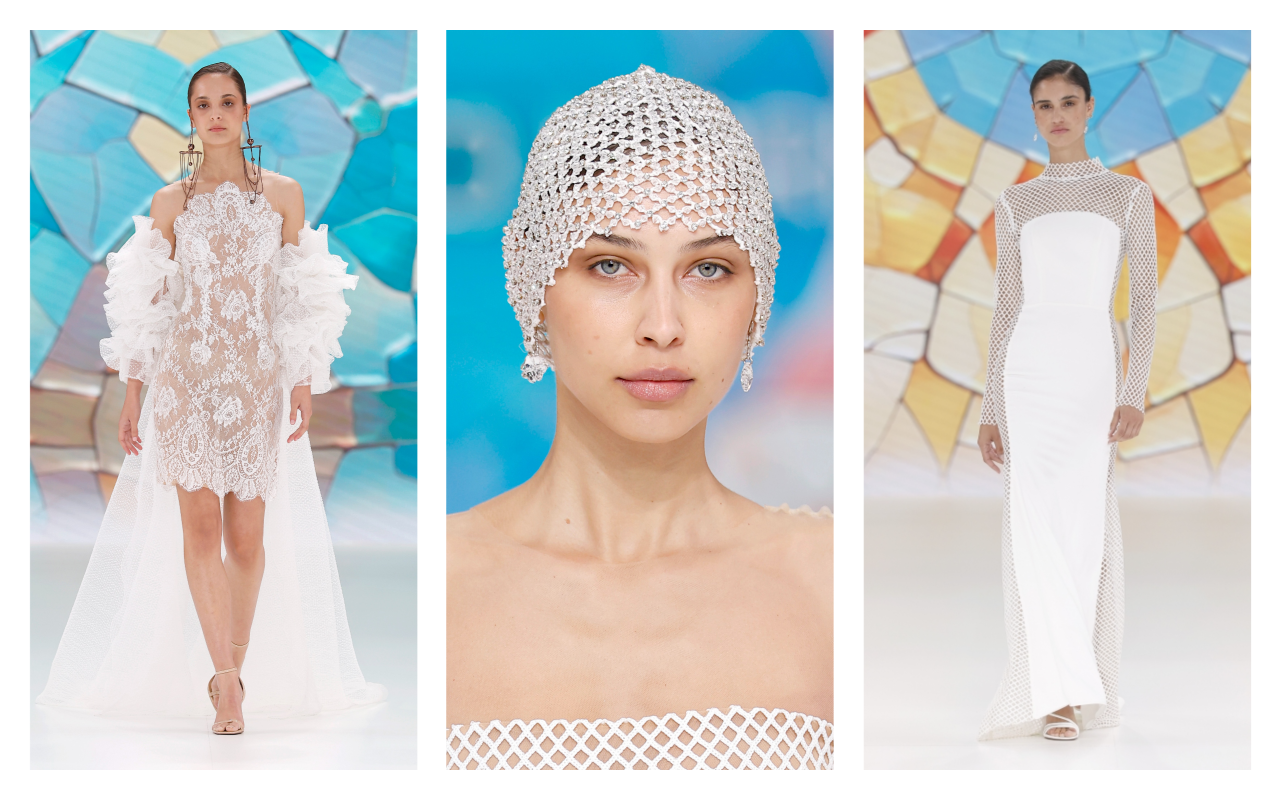 Mariano Moreno runway show. Photo: Barcelona Bridal Week 2025
Mariano Moreno runway show. Photo: Barcelona Bridal Week 2025
Mariano Moreno, a wedding tribute to Gaudí
At Barcelona Bridal Fashion Week 2025, Mariano Moreno presented his “I DO” collection, a design that pays homage to the city of Barcelona and the centuries-old legacy of Antoni Gaudí. Inspired by Catalan modernist architecture, the designer created unique pieces that fuse art, volume, and organic forms with haute couture.
The collection stands out for its reinterpretation of iconic architectural elements, such as the modernist facades and Gaudí’s signature undulating structures. The dresses incorporate details evoking the Sagrada Familia and Casa Batlló, using fabrics that mimic the textures and shapes of these monuments. The use of sculptural volumes and seamless finishes reflects the essence of Catalan modernism in each design. With “I DO,” Mariano Moreno continues his mission to redefine luxury in bridal fashion, combining creativity, sustainability, and a contemporary vision. His designs seek to make every bride feel authentic and unique, fusing the magic of haute couture with elements that celebrate the identity and cultural heritage of Barcelona.
This collection stands out not only for its innovative aesthetic, but also for its commitment to sustainability and local craftsmanship, consolidating Mariano Moreno as a key figure in the evolution of contemporary bridal fashion.
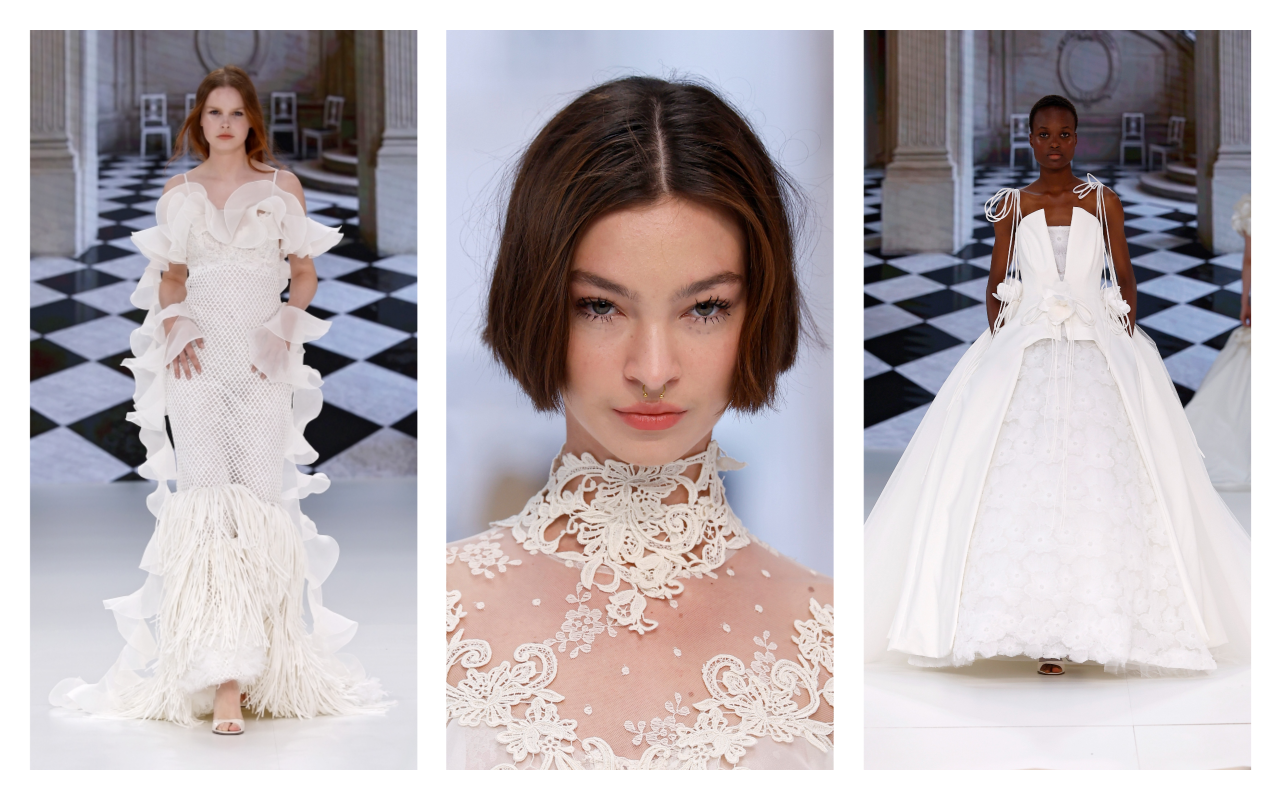 Yolancris runway show. Photo: Barcelona Bridal Week 2025
Yolancris runway show. Photo: Barcelona Bridal Week 2025
Yolancris , the beauty of imperfection
At Barcelona Bridal Fashion Week 2025, Yolancris presented its ” Paradoxe ” collection, an ode to the duality between tradition and innovation. The firm, directed by Yolanda Pérez, fused bohemian spirit with haute couture, highlighting hand-painted tulle, silk mikados, Calais lace, and silk-preserved flowers.
The collection celebrated “perfect imperfection,” seeking sincere and creative beauty. The staging included an interview fragment with Japanese designer Yohji Yamamoto, emphasizing the importance of quality in creation. ‘ Paradoxe ‘ reaffirms Yolancris ‘s commitment to sustainability and craftsmanship, offering designs that reflect authenticity and innovation in contemporary bridal fashion.
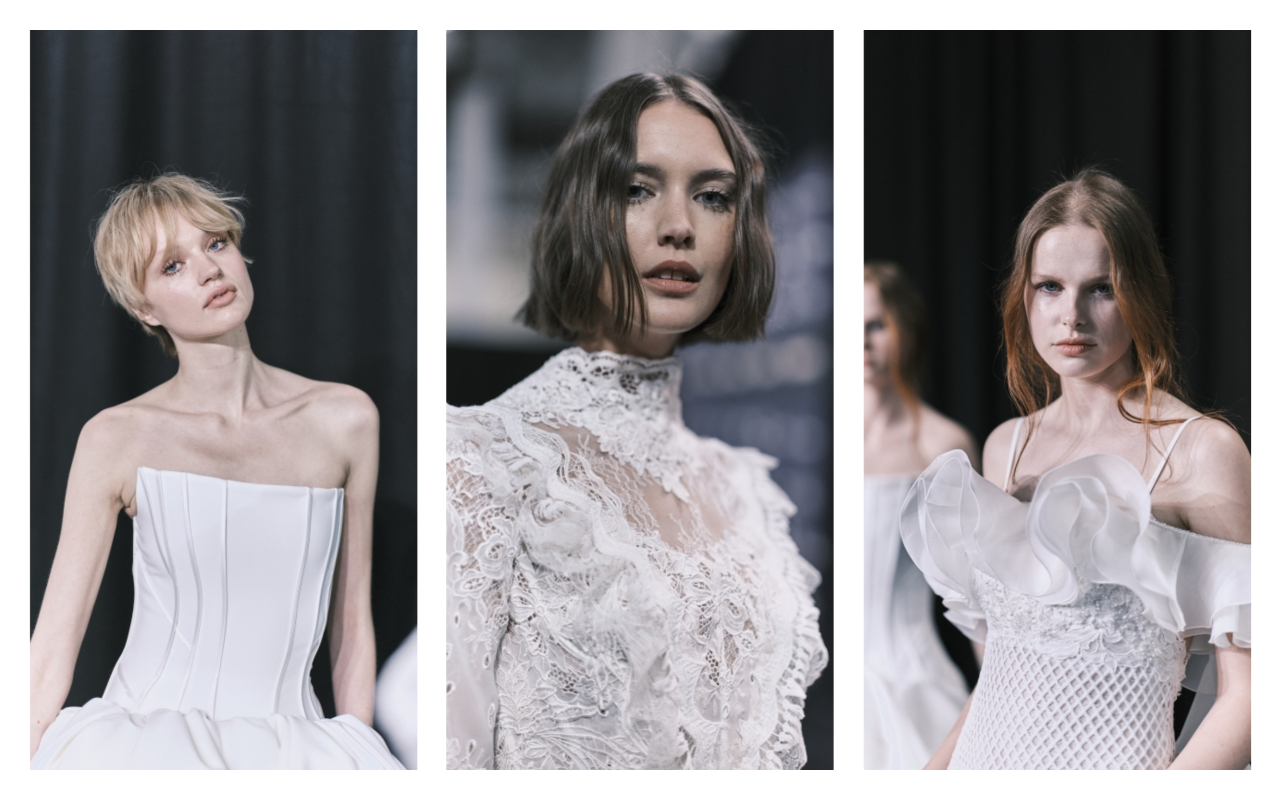 Backstage Yolancris. Photo: Barcelona Bridal Week 2025
Backstage Yolancris. Photo: Barcelona Bridal Week 2025
What is today’s bride looking for? Deciphering some trends
The 2026 bride abandons traditional molds to embrace a new way of understanding her dress: as an extension of her personality, her roots, and her way of feeling. This season, bridal fashion is evolving toward a plural and emotional aesthetic, where each piece exudes freedom, naturalness, and conscious sophistication.
Fabrics are the soul of this new bridal collection. Botanical textures—floral embroidery, 3D appliqués, nature-inspired lace—dominate the most prominent collections, evoking a return to the essential and a connection with the environment. Alongside them, noble materials such as silk, crepe, tulle, and taffeta reaffirm the value of craftsmanship and quiet luxury.
Silhouettes are becoming more versatile: transformable dresses with detachable capes, removable sleeves, or skirts that adapt to every moment of the big day. This modularity allows the bride to experience the ceremony, the celebration, and the party with a single design, true to her essence and comfort.
In terms of form, several currents coexist: structured minimalism, sculptural volume as an art form, romanticism reinterpreted with a contemporary language, and, above all, extreme customization. Each dress seeks not only to beautify, but to tell a unique story.
The colour palette is also evolving: alongside classic white and ivory, shades of blush, lavender, soft green, terracotta, and subtle metallic sparkles are emerging, adding character and modernity.
The bride of today—and tomorrow—wants to enter her new life wrapped in fabrics that caress, structures that inspire, and details that move. A brave, sensitive, and authentic bride who understands her dress as a personal work of art, not just a simple tradition.
We also take this opportunity to invite you to discover our collection of bridal fabrics , designed to create dresses that excite, inspire, and celebrate unique stories.
When fabric tells stories: a look at the latest edition of 080 Barcelona Fashion
 Lola Casademunt by Maite. 080 Barcelona Fashion
Lola Casademunt by Maite. 080 Barcelona Fashion
080 Barcelona Fashion once again demonstrated in its April 2025 edition why it is much more than a catwalk: it is a stage where fashion takes on meaning through storytelling, emotion, and material. This edition reaffirmed its essence as a hybrid platform, where commercial brands and independent designers coexist, creating a vibrant ecosystem that celebrates creativity in all its forms. Far from being a simple succession of trends, 080 focuses on proposals with soul, capable of telling stories through silhouette, volume, and, above all, fabric.
The Catalan runway was filled with contrasts: nostalgia and modernity, sensuality and fantasy, structure and fluidity. Each collection offered a unique perspective, but they all shared one thing in common: textiles as the guiding thread of the message . There is fashion that screams and fashion that whispers, and in this edition, the language of materials was the true protagonist.
Some designers appealed to craftsmanship and the value of manual gestures; others to theatricality or emotional symbolism. Between established names and new voices, creative freedom and an author’s vision prevailed, with exquisite attention to finishes, textures, and construction.
At this crossroads of styles and generations, brands as diverse as Lola Casademunt , Compte Spain, Anel Yaos , and Juan Vidal shone for their understanding of fashion as a form of intimate expression. These designs transform fabric into a silent narrator of emotions, ideas, and beauty. Here are the most inspiring collections.
 Lola Casademunt by Maite. 080 Barcelona Fashion
Lola Casademunt by Maite. 080 Barcelona Fashion
The Catalan firm presented its collection “ Misty ” Coast ,” a proposal for next fall-winter inspired by the misty sunsets of the Normandy coast. An enveloping and sophisticated aesthetic, true to the DNA of Lola Casademunt by Maite, which combines the classic and the contemporary with a very feminine look. On this occasion, the nautical spirit is reinterpreted with polka dots, chunky knit stripes, embroidered wools, and touches of bougainvillea, forest green, or sorbet pink that break the sobriety of black.
Lightweight materials like silk and viscose blend with warm textures like cool wool, and shiny details add a glamorous touch . A collection designed for a woman who embraces sophistication without sacrificing comfort or personality.
Lola Casademunt was founded more than 40 years ago in Cardedeu, Barcelona, when Lola Casademunt began handcrafting hair accessories. Her daughter, Maite Casademunt, joined the project at a young age, bringing a fresh vision focused on fashion design. Since 2018, she has led the company as president and creative director, leading both the eponymous line and its premium line, “Lola Casademunt by Maite.”
With “ Misty Coast ”, the firm reaffirms its ability to create coherent, elegant collections with a touch of daring that never goes unnoticed. Compte Spain. 080 Barcelona Fashion
Compte Spain. 080 Barcelona Fashion
Fashion as a fairy tale, fabrics as catalysts of magic. This is how “ Objet” presents itself. “Found ”, the collection that Santi Mozas , creative director of COMPTE SPAIN, brought to the catwalk in 2080. A prêt -à- couture proposal that transforms the enchanted symbols of classic tales—a glass slipper, a magic mirror, a golden thread—into a contemporary metaphor. Elements that, as in fairy tales, transform the course of history.
With 25 intentional looks, the collection reinterprets feminine codes through a sophisticated and theatrical lens. Shiny tweeds, sequins, sheer drapes, feathers, and handcrafted appliqués create a visual universe of textile richness. The burgundy, black, white, light blue, and taupe colors reinforce the play between the ethereal and the intense that defines the brand’s imagery.
COMPTE SPAIN is a Spanish brand that focuses on signature fashion. Its collections—handmade in Spain—are born from the imagination of fairy tales, but decontextualized, removed from the obvious narrative. The brand is committed to ethical and local production, respecting both the creative process and the artisans who make it possible.
“Object Trouvé ” is not just a collection, but a reflection on the transformative power of small details. A tribute to slow fashion with a narrative soul.
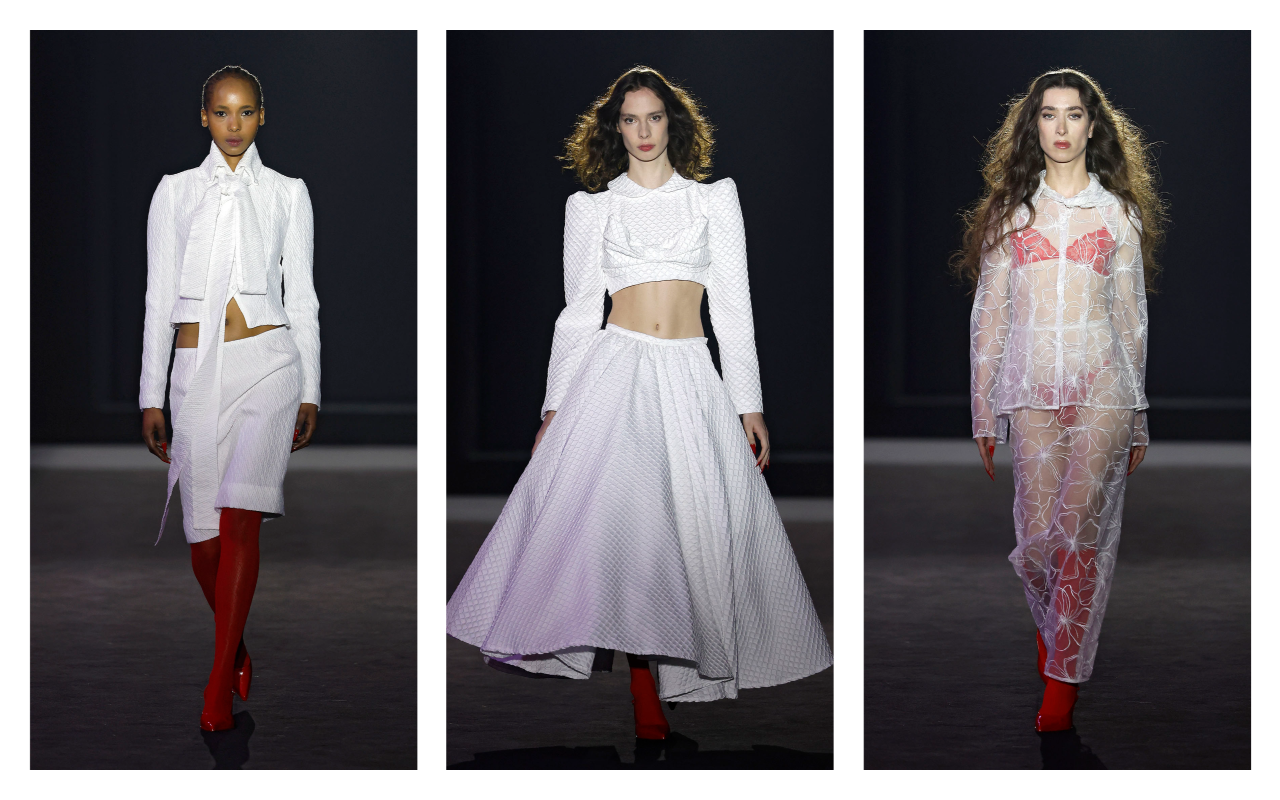 Anel Yaos. 080 Barcelona Fashion
Anel Yaos. 080 Barcelona Fashion
Anel Yaos
With “MARÍA,” Anel Yaos transforms white into a poetic canvas on which to project emotions, shapes, and textures. A deeply personal proposal—inspired by her sister, her other self—that explores all the possibilities of this seemingly neutral color, yet full of nuances: chalk, mother-of-pearl, marble, bone… Here, white becomes a symbol of purity, but also of strength and refuge.
True to his naive and dreamlike universe, the Andalusian designer brings to life silhouettes that combine delicacy and drama, with layering, organic volumes, and a rich mix of fabrics that reinforce the collection’s narrative. Neoprene, lace, wool, knit, faux leather, and silk merge into an ethereal and tactile atmosphere, where each garment seems to speak from within.
“MARÍA” is not just an aesthetic proposal, it’s an emotional statement. Anel Yaos’s fashion channels generational sentiments: insecurities, yearnings, the pressure to fit in, and, at the same time, the search for pure and genuine happiness. Through white, the designer transforms silence into a serene cry.
Trained in various disciplines related to design, art, and communication—between Seville and Barcelona—Anel Yaos has built a brand recognized for its authenticity, tenderness, and ability to move without artifice. In this edition of 080, he once again reminded us that fabrics don’t just dress, they also caress the soul.
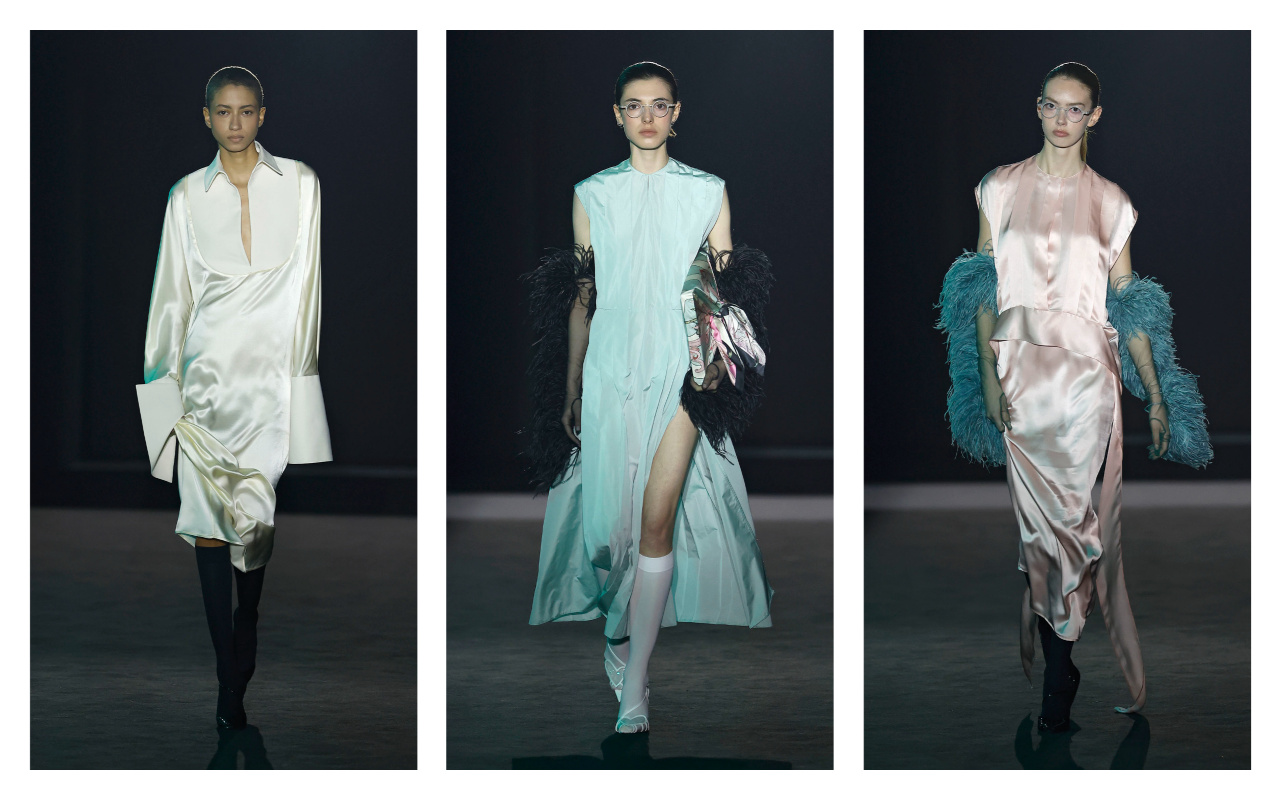 Juan Vidal. 080 Barcelona Fashion
Juan Vidal. 080 Barcelona Fashion
Juan Vidal
In his latest collection, “He loves me, he loves me not,” Juan Vidal transforms vulnerability into visual poetry. Plucking the petals of a daisy is a symbolic act of uncertainty and searching. A playful gesture that, in the hands of the Alicante-born designer, becomes an aesthetic reflection on identity, duality, and the desire for certainty in an unstable world.
With her unmistakable emotional sophistication, Vidal constructs a collection where opposites harmoniously intertwine: rigid and fluid, matte and glossy, masculine and feminine. Pistils, petals, floral woodcuts, gabardines, and washed satins make up an ethereal and profound collection that fearlessly caresses indecision, elevating it to an aesthetic experience.
Trained in Fine Arts and fashion design in Barcelona, Juan Vidal is one of the key names in contemporary Spanish fashion. From his early days—when he won the FAD award for his student collection—to becoming a winner of awards such as the Who’s From Vogue’s On Next to the National Fashion Award, her career has been defined by impeccable technique, a masterful command of volume, and a conceptual approach that draws on both art and textile tradition.
On the 080 catwalk, Vidal reaffirms her highly personal vision of fashion: dresses that not only dress, but provoke, excite, and seduce. Because sometimes, truly powerful things come from embracing doubt.
The most inspiring Portuguese fashion
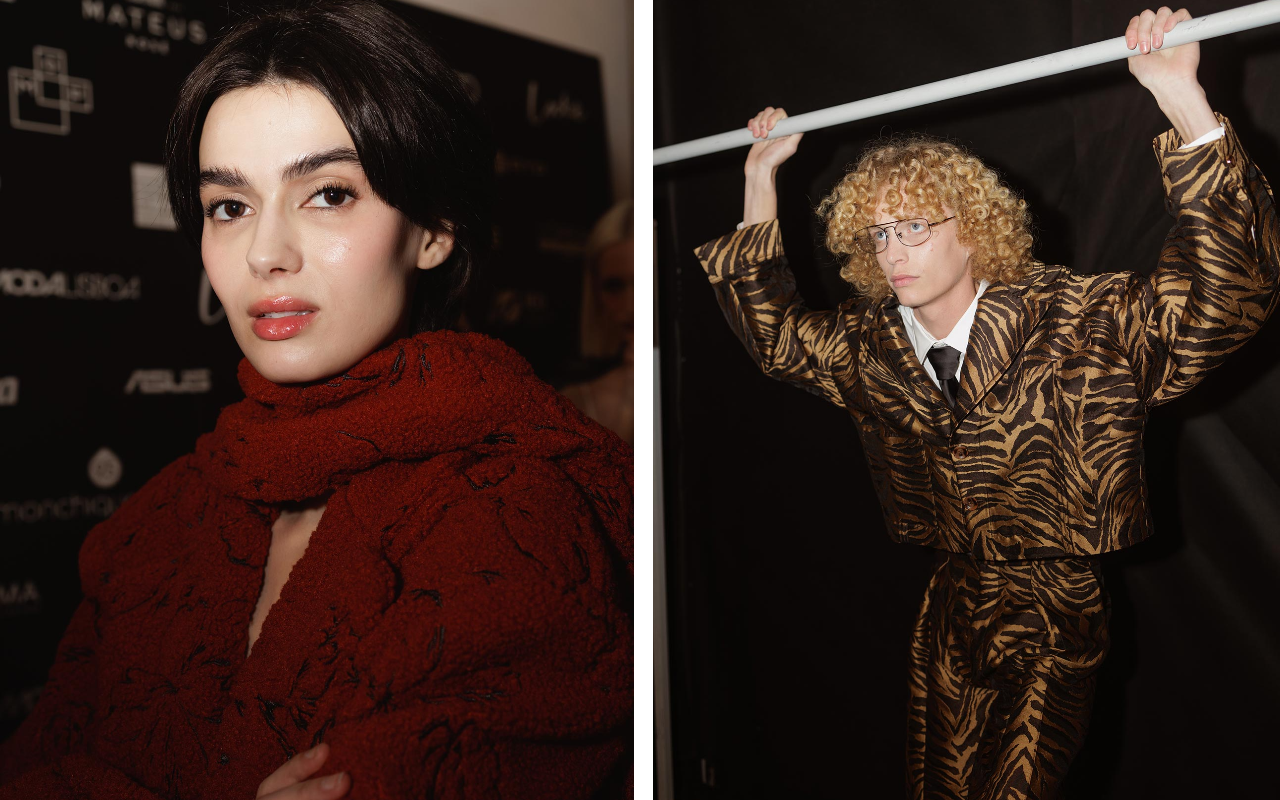 Pics by Ugo Camera
Pics by Ugo Camera
Forget London, Paris, Milan, Copenhagen, or Madrid. Or rather, introduce a new dimension to the leading European fashion capitals. Lisbon is in the spotlight in the fashion sector and has become a hotbed of trends in recent years. The city, with its vibrant and cosmopolitan atmosphere, has managed to merge its rich history with a vibrant creative scene. And this shift is evident both in the creative and practical spheres.
A new generation of independent designers has revitalized the Portuguese fashion scene, complementing established brands and achieving recognition both at home and abroad. This boom is no coincidence: the combination of a strong textile tradition, a commitment to sustainability, and a fresh, contemporary approach to design have positioned the Portuguese capital as a strategic hub for the industry.
The legacy of textile tradition remains alive
Nothing would make sense without this premise: Portugal is one of Europe’s leading textile producers, with factories that work for some of the world’s most prestigious brands. And it remains so today despite the relocation of its industrial fabric to emerging economies in Asia and Africa.
From organic cotton to the most innovative techniques in the production of sustainable fabrics, the Portuguese textile industry has evolved without losing its local and artisanal essence. In regions such as the Ave Valley and Guimarães, workshops and factories that combine artisanal know-how with cutting-edge manufacturing processes are concentrated, allowing many brands to focus on local production. This textile heritage has been key to the development of emerging designers who seek to differentiate themselves through quality and innovation. It is also important to note that this proximity also provides greater direct access to the consumer, turning fashion into a good that encompasses quality, proximity, and the prestige of the region.
Lisbon Fashion Week , the nerve centre of Portuguese fashion
It’s not the biggest or most media-driven catwalk show in terms of coverage, but it’s the one that’s gaining increasing relevance for offering the industry a fresh and different perspective. ModaLisboa not only presents fashion shows but also fosters dialogue and learning through talks and workshops, highlighting not only designers but also the country’s creative ecosystem. With each edition, Lisbon reaffirms its position as the epicentre of innovation, consolidating its unique identity within the European fashion landscape.
Lisbon Fashion Week, also known as ModaLisboa, is the benchmark event for Portuguese fashion. Founded in 1991, it has become a key platform for both emerging and established designers. Its focus on sustainability and unrestricted creativity have set it apart on the international fashion week circuit.
ModaLisboa is held twice a year and brings together designers, buyers, and media to present the season’s collections. Rather than being confined to a single exhibition venue, its shows take place in iconic venues around the city, such as the Pavilhão Carlos Lopes or the Palácio Sinel de Cordes, turning the Portuguese capital into a fashion scene in itself.
One of its fundamental pillars is support for emerging talent, embodied in initiatives such as Sangue Novo. This program gives visibility to young designers, providing them with a platform to showcase their work and facilitating their entry into the industry. With this commitment to creativity and innovation, ModaLisboa not only promotes Portuguese fashion but also reinforces its role as a key event on the international scene.
Designers who catch our attention
There’s a wealth of talent, with proposals ranging from the most established to the most disruptive. At Gratacós, we keep an eye on designers and brands that regularly show at Lisbon Fashion Week, as well as other independent labels that are setting the pace in Portuguese fashion. Below, we highlight some of the designers who inspire us the most:
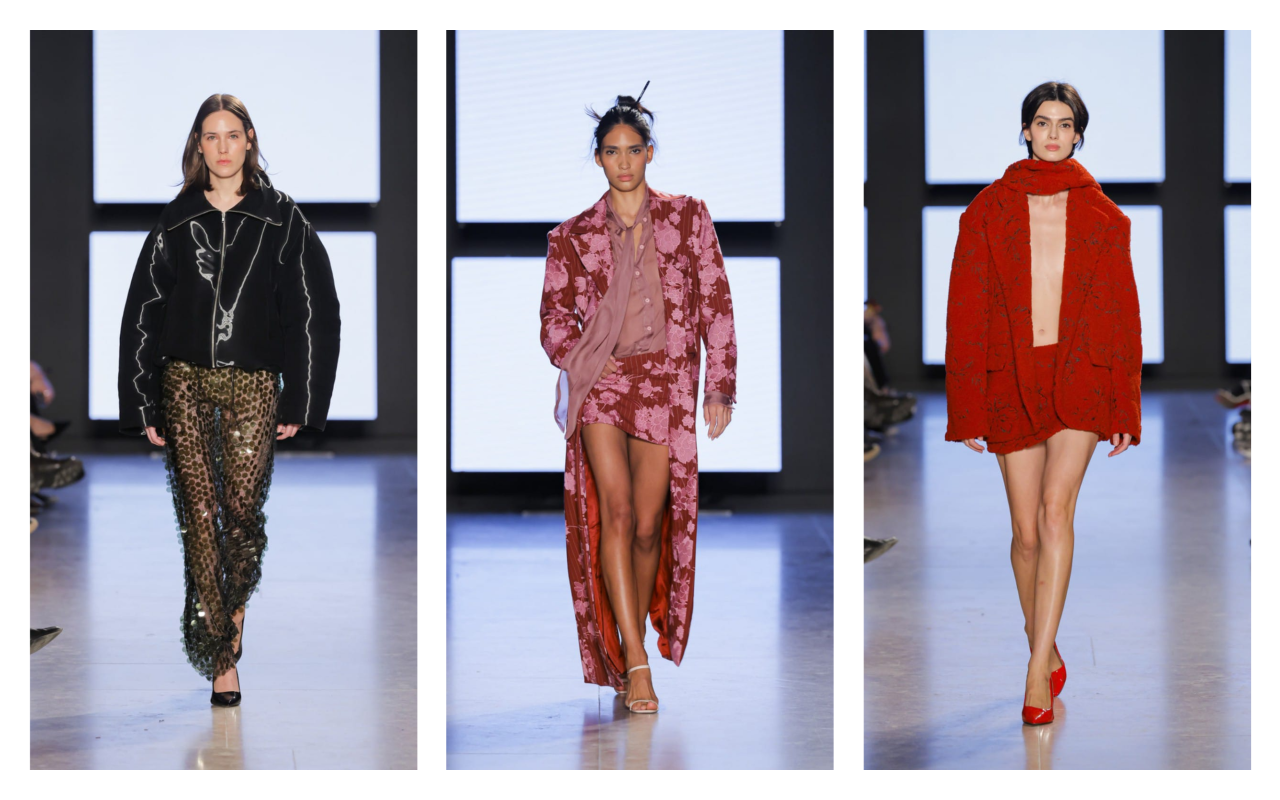 Pics by Ugo Camera
Pics by Ugo Camera
Gonçalo Peixoto
Gonçalo Peixoto is a young designer who began his training in Fashion Design in 2012 in Guimarães, and later graduated from ESAD in Matosinhos. From his earliest studies, he has proven to be a passionate artist, driven by his love of fashion and his desire to create. His collections have captured the attention of renowned fashion stores and specialized publications, quickly establishing himself on the Portuguese scene.
In September 2017, Gonçalo presented his first collection at London Fashion Week, and in March 2018 he joined the official ModaLisboa calendar, where he began showing his collections regularly.
With a youthful and sophisticated aesthetic, Peixoto embraces modern femininity, reinterpreting trends with a fresh and bold vision. Her latest collections, presented at Lisbon Fashion Week, frequently feature surprising combinations: metallic fabrics, sheer layers, and asymmetrical cuts, reflecting a contemporary vision of fashion. Vibrant colours and fitted silhouettes are often the focus of a collection designed for a self-confident woman with a strong personality.
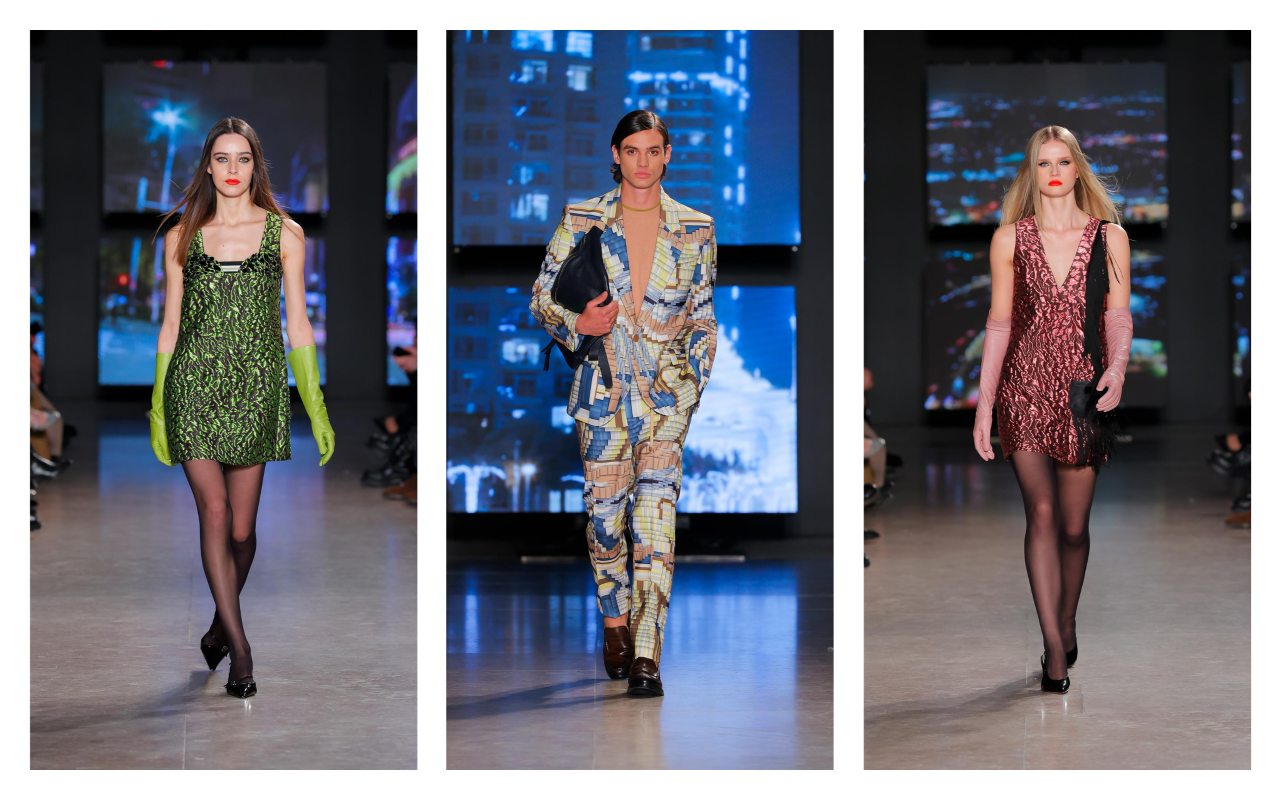 Pics by Ugo Camera
Pics by Ugo Camera
Carlos Gil
Carlos Gil is a designer with a solid track record, recognized for his mastery of pattern making and his ability to balance the classic with the contemporary. Born in Nampula, Mozambique, in the late 1960s, Carlos Gil trained in Fashion Design in Portugal. In 1998, he opened his atelier in Fundão , the city where he lives and works, and a few years later, he opened his first store under the CARLOS GIL brand.
Carlos Gil regularly presents his collections at ModaLisboa and has successfully conquered international markets through his participation in major fashion weeks. Throughout his career, he has received numerous awards and recognitions, such as the Medalha de Mérito da Cidade do Fundão (2009), the Premio Jovem de Sucesso (Young Success Award ) in Portugal and abroad (2009), and the Commenda de Gran Oficial de la Orden del Infante D. Henrique (Command of Grand Officer of the Order of Infante D. Henrique) (2015).
The designer stands out for his ability to create striking pieces of remarkable quality, with an approach that combines sophistication and elegance. His collections are cosmopolitan and contemporary, yet always maintain a strong distinction. In his latest offerings, Gil has explored sophistication through structured fabrics, volumes, and embroidered details. The color palette ranges from neutral tones to bold color accents that bring dynamism to each look. His style reflects an updated retro vibe, with influences from the elegance of the 1970s reinterpreted for today’s audience.
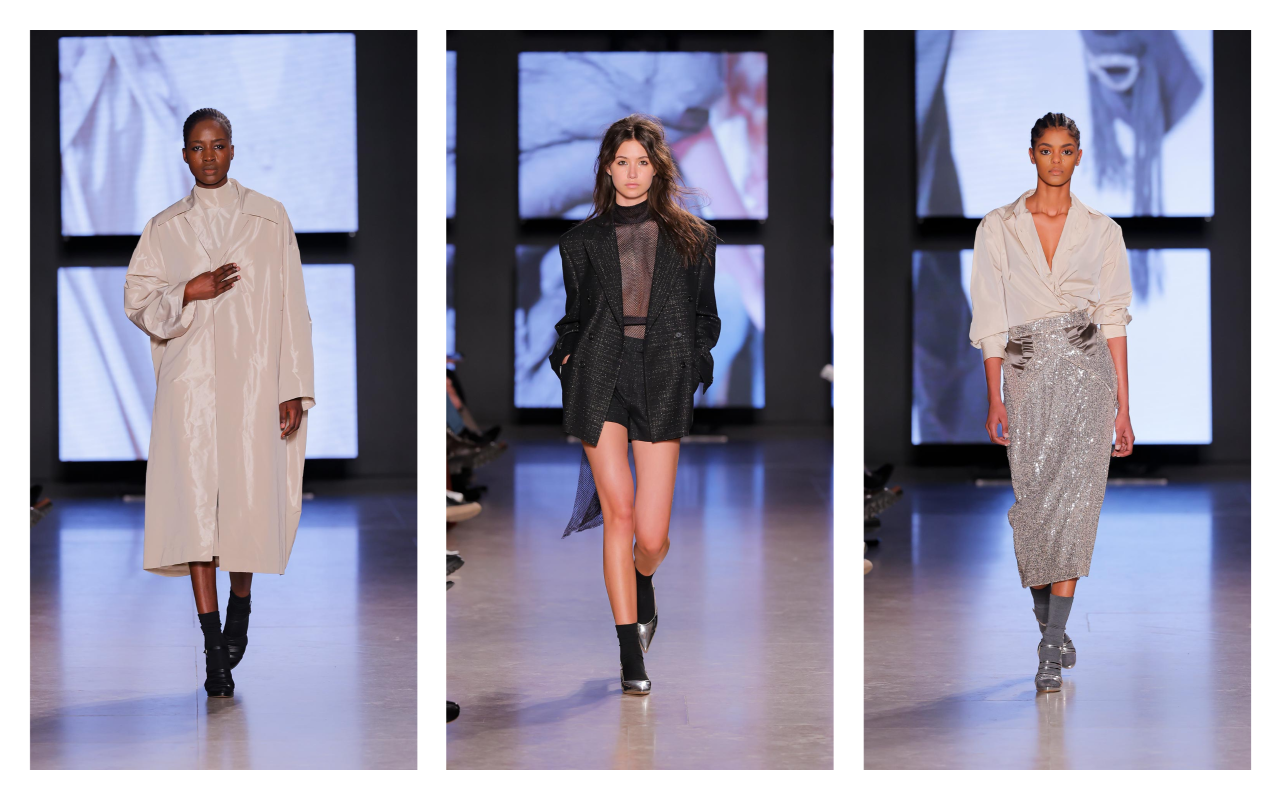 Pics by Ugo Camera
Pics by Ugo Camera
Nuno Balthazar
Nuno Baltazar is one of the most important designers in Portuguese fashion. He trained in Fashion Design at Citex (now Modatex ) and from his earliest days stood out for his talent, winning awards such as Young Designers from Máxima Magazine and Porto Moda. In 1999, he began presenting his collections at ModaLisboa , initially with Cravo, and in 2004, he launched his own brand.
In 2005, he opened his store in Porto and created unique pieces under the label Nuno Baltazar Atelier, collaborating with figures such as Carminho , Raquel Strada , and Victória Guerra. He has also designed the image of presenter Catarina Furtado and worked on costumes for television and theatre. Throughout his career, he has received awards such as the Fashion Award from Fashion TV Portugal (2011) and the Golden Globe for Best Designer (2013). In 2020, he returned to the ModaLisboa runways with his signature collections.
Nuno Baltazar is characterized by his minimalist approach and meticulous attention to detail, which has made his brand a benchmark in contemporary fashion. In his latest collections, he has showcased a series of pieces that fuse refined cuts with texture-rich materials, such as lightweight wools and printed silks. Reinvented tailoring has been a cornerstone of his designs, highlighting unstructured suits and a fusion of masculine and feminine, always with his signature touch.
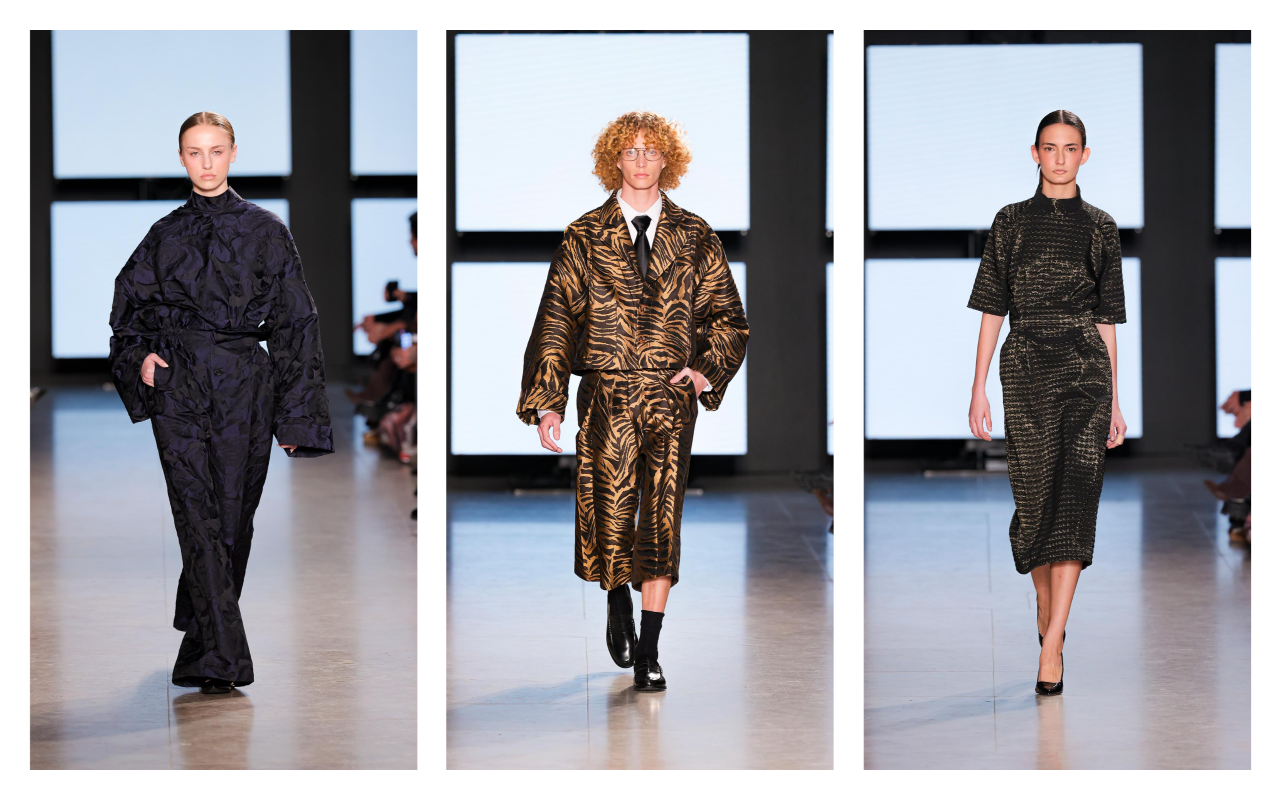 Pics by Ugo Camera
Pics by Ugo Camera
Luis Carvalho
Luís Carvalho , originally from Vizela , trained in Fashion and Textile Design at the Polytechnic Institute of Castelo Branco. Throughout his career, he has participated in various fashion competitions and worked at ModaLisboa and in the ateliês of renowned designers such as Filipe Faísca and Ricardo Preto . He was a designer at Salsa Jeans for two and a half years before creating his own label in 2013, debuting his first collection at ModaLisboa. That same year, he opened the LUIS CARVALHO | studio in Vizela, a combination of his atelier and his own store. Carvalho has received several awards, including the “Maison Mode Mediterranée” Prize in Marseille (2018 and 2019) and has presented her work in Paris, at the Moda Portugal Showcase.
The designer is known for dressing numerous public figures, both nationally and internationally. His creative approach has established him as a creator who challenges the boundaries between the conceptual and the commercial. His designs are distinguished by their experimentation with shapes and materials, opting for architectural volumes and high-quality fabrics. In his recent collections presented at Lisbon Fashion Week, Luis Carvalho has opted for garments that explore structure and movement. The fusion of geometric cuts and subtle draping has added fluidity to his designs, creating a contemporary and sophisticated aesthetic that defines his style.
At Gratacós, we’re closely following these events, which celebrate not only fashion but also the culture and identity of Portugal. The next edition promises to be even more exciting and full of surprises!
(Español) Twiggy aterriza en Barcelona y mucho más en el Moritz Feed Dog 2025
Welcoming the new SS25 collection

At Gratacós, creativity and innovation are part of our essence. As creators and suppliers of fabrics for the major fashion houses, international brands and designers, our mission in each collection is to anticipate trends and offer items that define the future of fashion through the senses. Fabrics that are eye-catching, but also seductive to the touch.
Every year, we present our collections at the world’s leading textile fairs, such as Première Vision (New York and Paris) and Milano Unica (Milan). These events allow us to share our proposals with international designers and brands, as well as to obtain valuable feedback to continue adapting to a constantly evolving market.
So in February, we exclusively unveiled our Spring-Summer 2026 collection, a preview of the trends that will mark the coming seasons. But now, it’s time to dive into the SS25 Collection, the current one that we sell on our website and in our space in Barcelona.
An ode to creativity, freshness and lightness
In general terms, the SS25 collection is born from the need to explore the naive and the pure, connecting us with our most spontaneous essence. From tenderness, freshness and sweetness, the new season transports us to a universe of lightness, where fashion becomes a refuge of kind and optimistic sensations.
This collection is designed for simple, yet sophisticated, effortless and versatile fashion, perfect for those seeking elegance without sacrificing comfort. Through innovative fabrics and high-quality finishes, the new proposal creates ethereal garments that celebrate the arrival of summer.
Colour
Colour is a fundamental pillar of the season. Beyond the neutrals, always elegant and combinable, the collection explores a palette of soft and delicate tones, from the most ethereal pastels to vibrant shades inspired by sugared flowers.
The shades evoke purity and freshness, with nuances reminiscent of sunny days, clear skies and natural light. A play of colours that allows for the creation of elegant and versatile combinations for the summer season.
Textures and reliefs
Gratacós fabrics stand out for their innovation and richness in textures. In this collection, jacquards provide depth and sophistication, while embroidery adds a touch of fantasy to next spring-summer fashion.
Prints will be the main feature, with designs carefully crafted to offer a balance between modernity and timelessness. Each fabric is designed to be transformed into unique garments, ready to come to life in the hands of the most demanding designers.
SS25 not only marks a new era in summer fashion, but also reaffirms Gratacós’ commitment to innovation, creativity and textile excellence. An invitation to dream, create and reinvent summer fashion. We invite you to discover it!
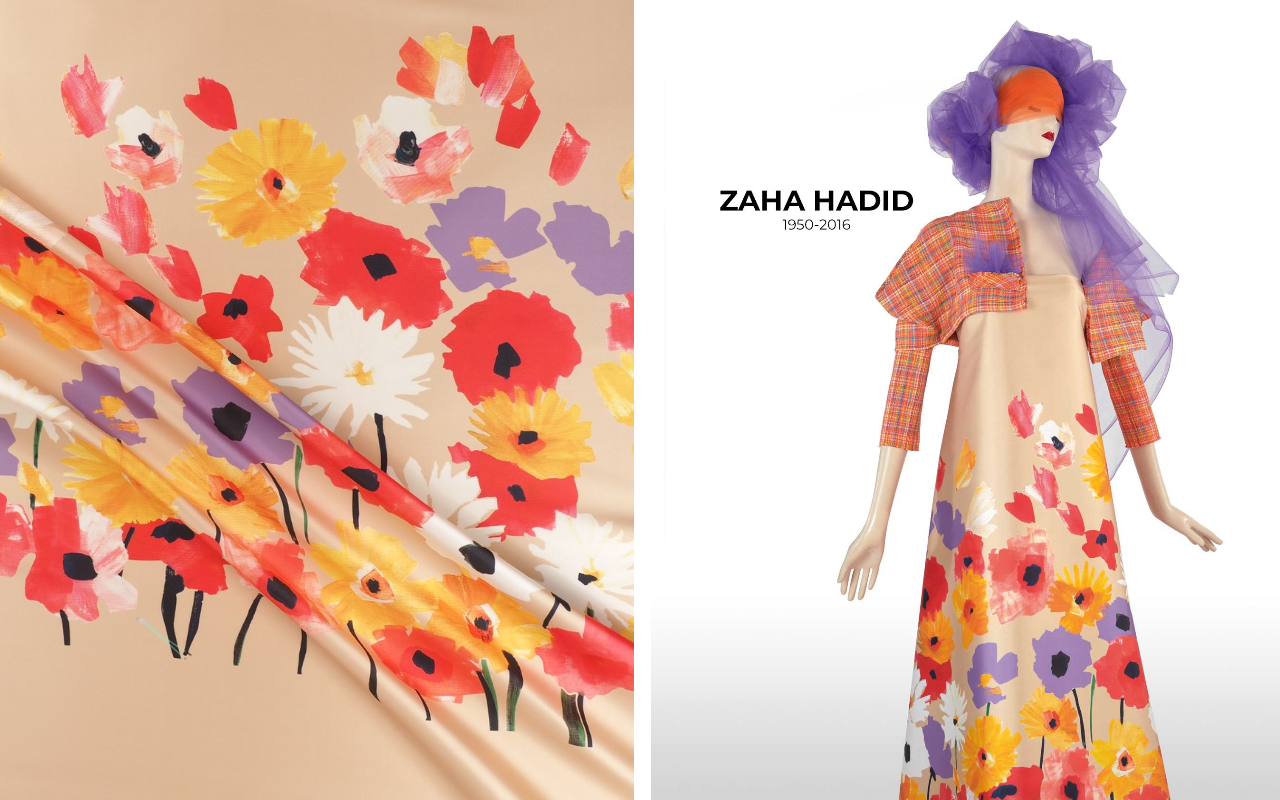
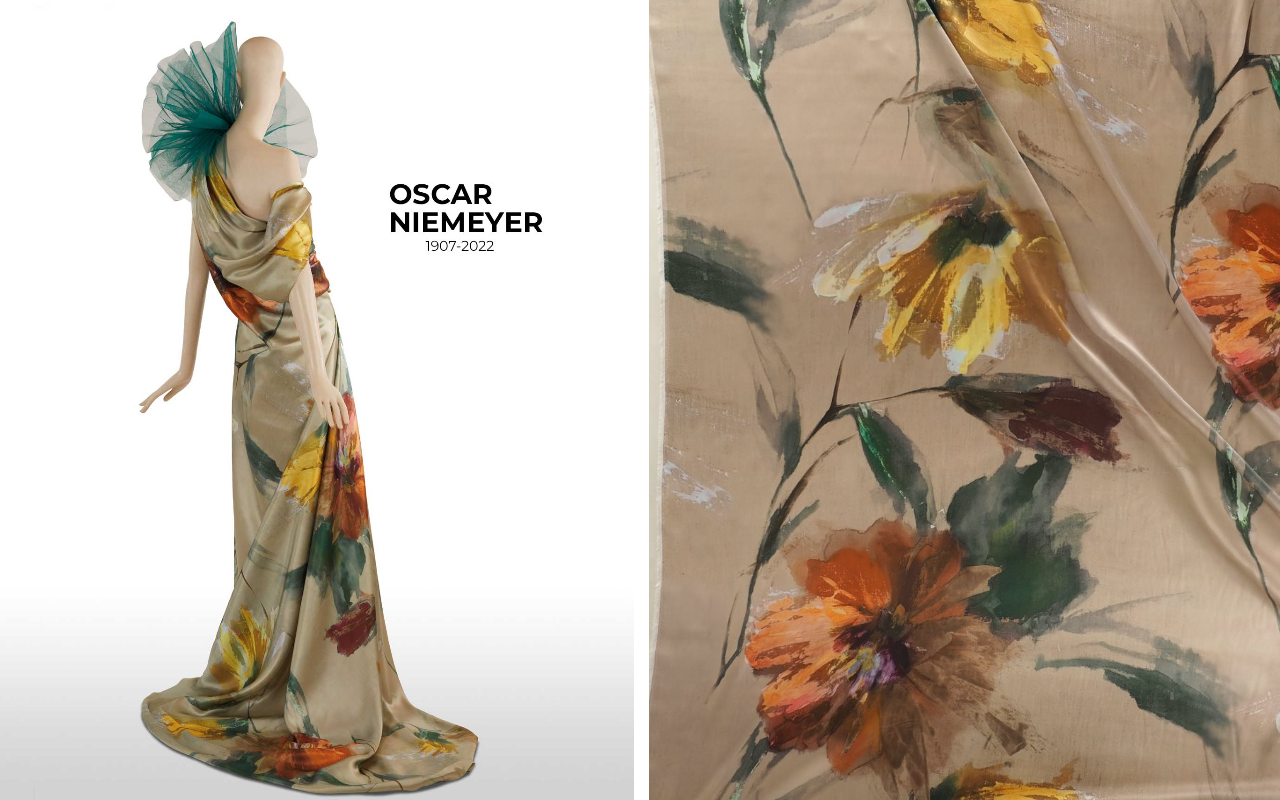
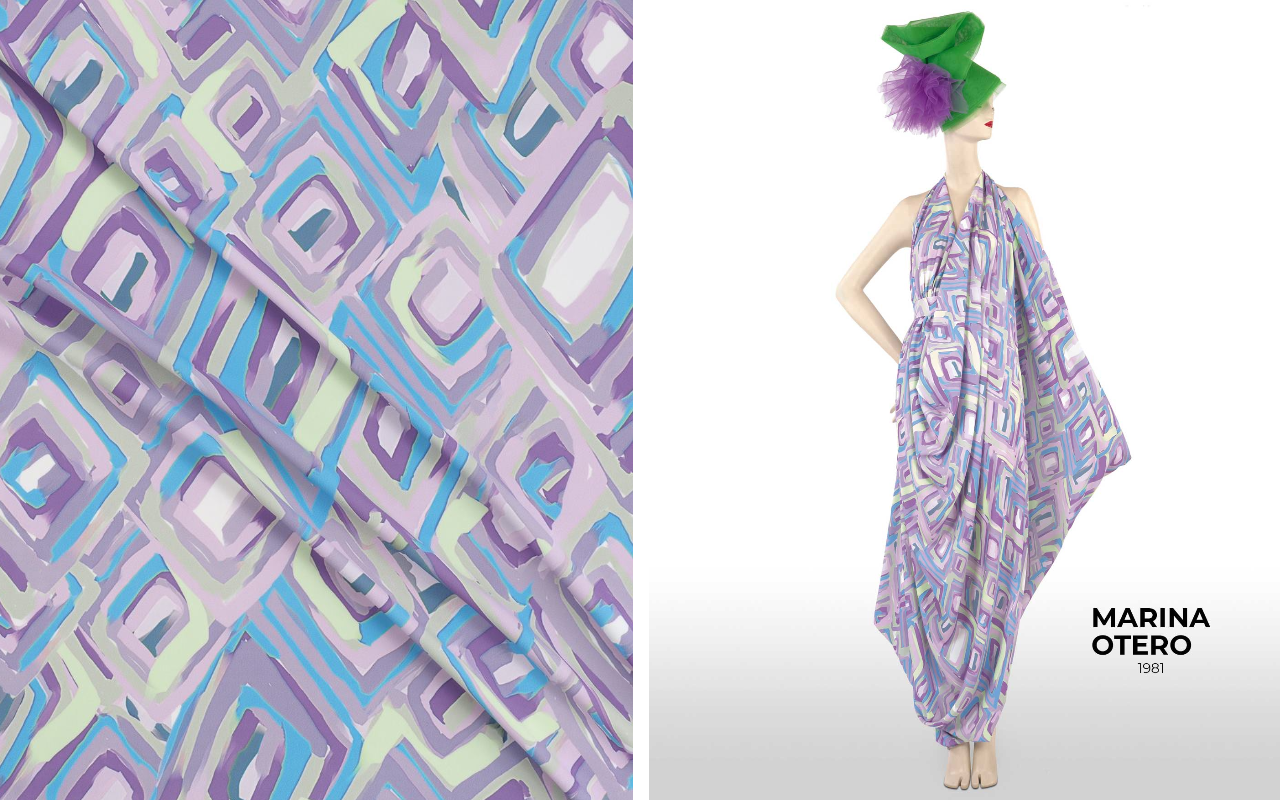
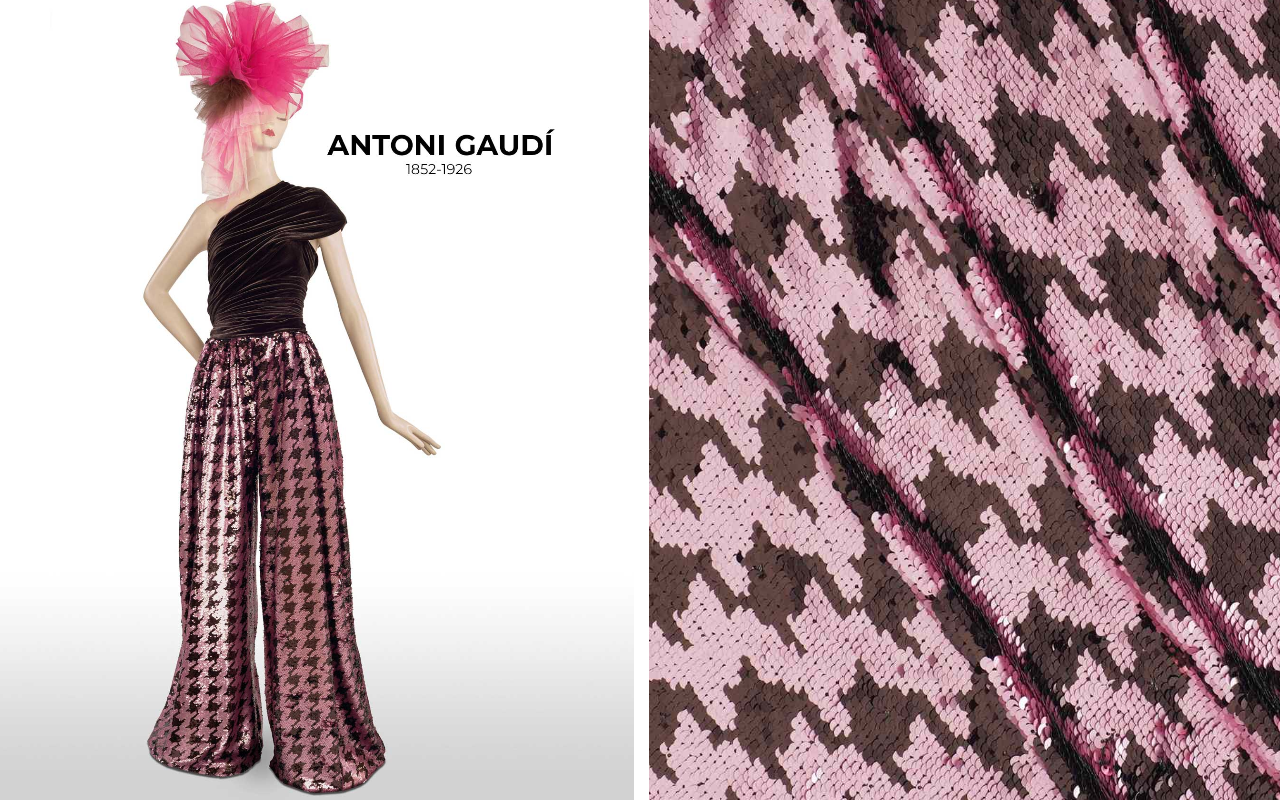
(Español) Diseños inspiradores de la Mercedes-Benz Fashion Week Madrid. Colecciones AW25/26
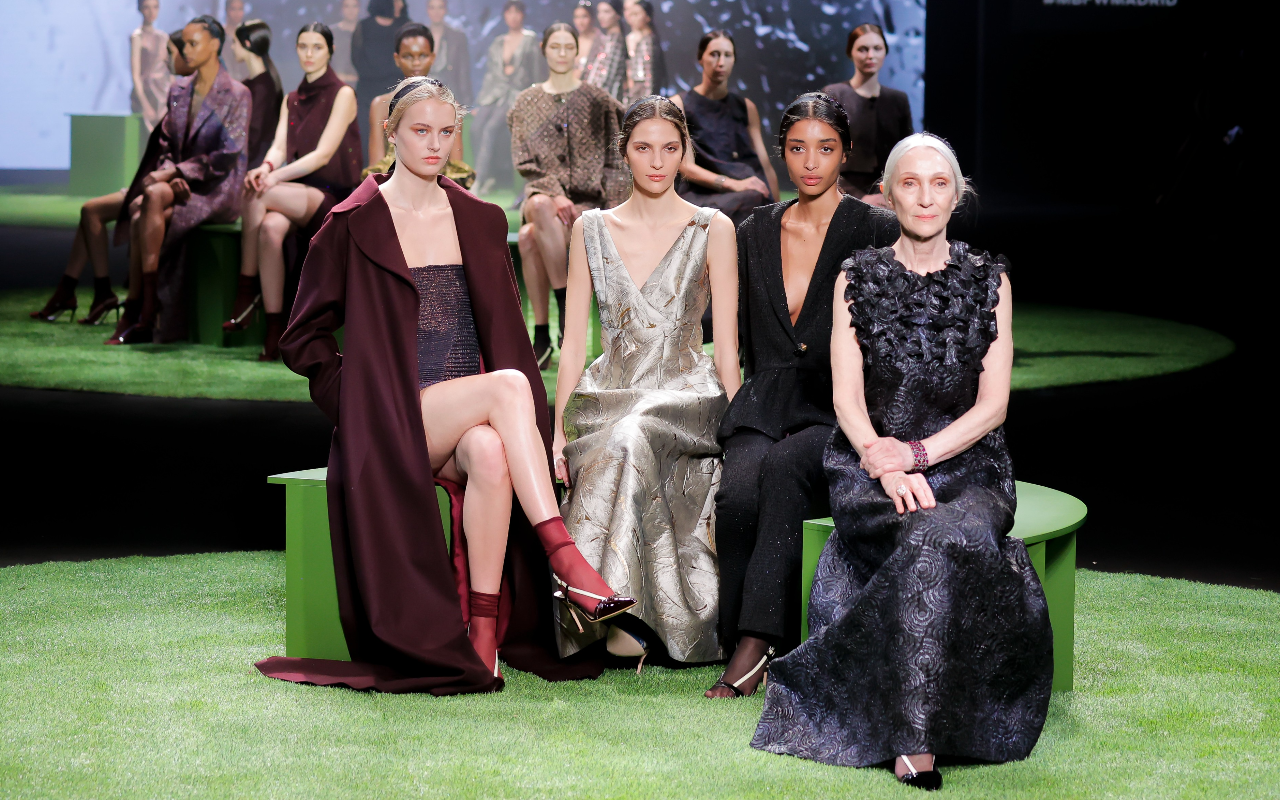 Fely Campo. Mercedes-Benz Fashion Week Madrid. Fall/Winter 2025/2026 Collection
Fely Campo. Mercedes-Benz Fashion Week Madrid. Fall/Winter 2025/2026 Collection
At Gratacós, we closely follow the main Spanish fashion catwalks, always looking to discover how our fabrics become unique pieces full of creativity. We are fascinated to see the transformation of our fabrics in the hands of designers, who manage to give life to collections full of personality and their own style. This connection between raw material and inspiration is, without a doubt, what motivates us the most to continue betting on innovation and quality.
During the recent edition of Mercedes-Benz Fashion Week Madrid, held in February 2025, we had the opportunity to once again see the trust that many designers place in our fabrics for their designs. Female empowerment, sustainability, experimentation with textures and the commitment to materials that combine tradition and technology have been some of the key themes of this season, where each garment not only stands out for its aesthetics, but also for the story behind it.
Below, we present a selection of the most outstanding shows of the Fall- Winter 2025/2026 season, where our fabrics have been the protagonists. It is a privilege to see how each designer explores new forms of expression and plays with textures to propose trends that inspire.
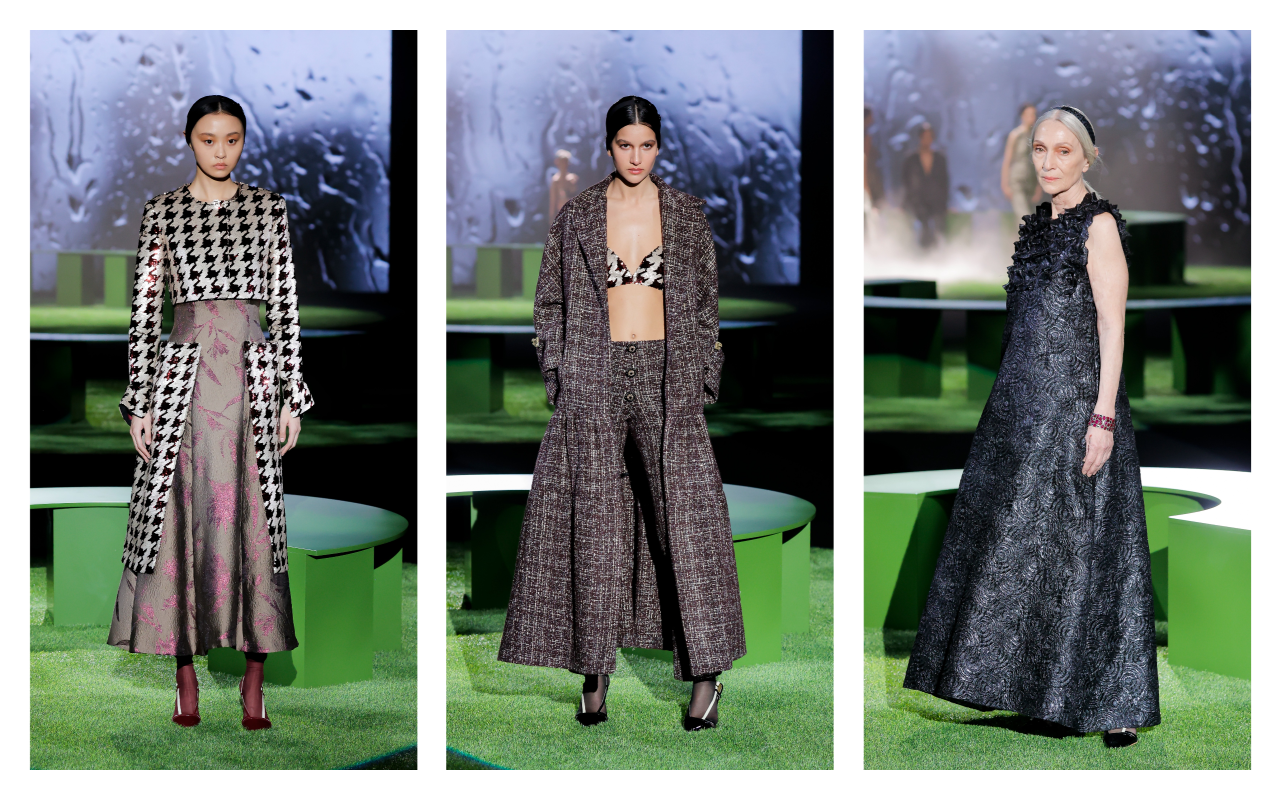 Fely Campo. Mercedes-Benz Fashion Week Madrid. Fall/Winter 2025/2026 Collection
Fely Campo. Mercedes-Benz Fashion Week Madrid. Fall/Winter 2025/2026 Collection
Fely Campo
Fely Campo has presented SELF><WORLD , a collection that invites us to reflect on the relationship between our identity and our environment. What do we project to the world? How is our inner self translated into the image we show? With these questions as a starting point, the designer from Salamanca proposes luxury ready-to-wear where personal essence and external expression merge into the same language.
The autumn-winter 2025/26 collection stands out for its balance between structure and fluidity, playing with materials that evoke emotions and awaken the senses. Tweed, with its enveloping texture, brings warmth and recalls tradition, while velvet is presented as a tribute to sensorial richness, combined with sequins and embroidery that suggest restrained shine and sophistication. Silk, light and ethereal, slides between the pieces, providing movement and softness, in contrast with heavier fabrics such as wool, creating a visual dialogue between the robust and the delicate.
The colour palette breaks free from conventions, breaking the traditional boundaries of colour. Deep tones intertwine with bright flashes, reflecting the multiple facets of the ” self ” and the diversity of emotional states. The versatility of the garments allows each woman to express herself in her own way, with designs intended for everyday use that do not renounce elegance or timelessness.
True to its commitment to sustainability, Fely Campo is committed to pieces that transcend the ephemeral. Each design is conceived to last, resisting the urgency of the new and embracing the beauty that endures over time. The refined and comfortable silhouettes enhance the female figure without imposing themselves, leaving room for the personality of the wearer to be the true protagonist. SELF><WORLD is an invitation to recognize and show oneself as one is, with garments that accompany, envelop and reflect the authenticity of each woman. Because, as the designer herself says, “beauty is in the eyes of the beholder.”
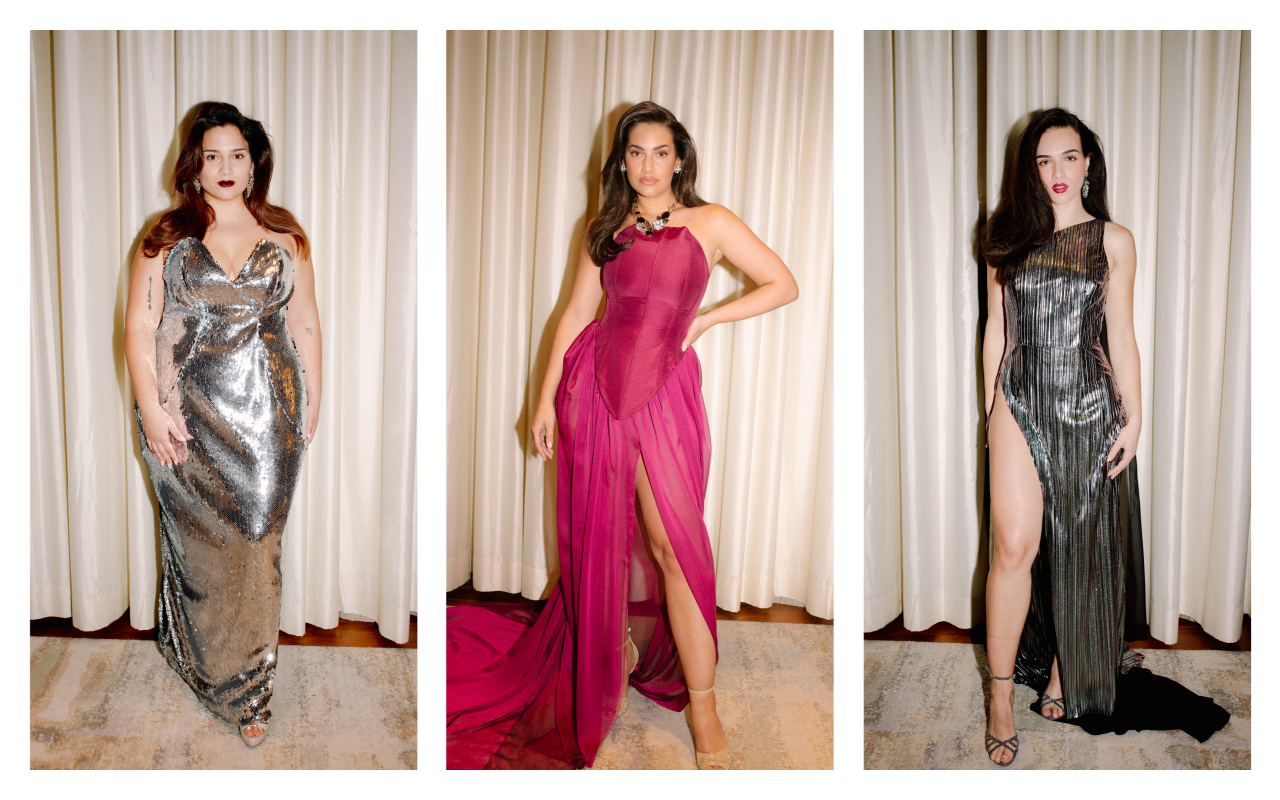
Johanna Calderon
Johanna Calderón chose the emblematic Four Seasons in Madrid to celebrate a fashion show that represents a hymn to body diversity. Each design by the Madrid native with an Andalusian heart is a declaration of self-love, an exaltation of feminine strength and sensuality. Sequins, rhinestones and transparencies took over the catwalk, drawing silhouettes that embrace the body with strategic cuts that enhance the figure without losing elegance. Her collection immerses itself in a festive universe where each garment celebrates self-affirmation. Subtle transparencies coexist with meticulous embroidery and fabrics that shine with their own light, conceived for women who want to feel powerful and radiant. More than fashion, it is a hymn to security and empowerment, with pieces that invite you to dress with confidence and freedom.
To bring this proposal to life, Calderón collaborated with Miah Management , the first Spanish agency dedicated entirely to curvy models. “I was not able to find such a diverse cast of models in any other agency,” explains the designer, a staunch defender of the real representation of women. Diversity was thus one of the central themes of the show, with sizes ranging from 38 to 56, vindicating beauty in all its forms. In short, Johanna Calderón transforms the act of dressing into an experience full of meaning, where sensuality and diversity intertwine to pay tribute to the modern woman: strong, confident and in control of her own story.
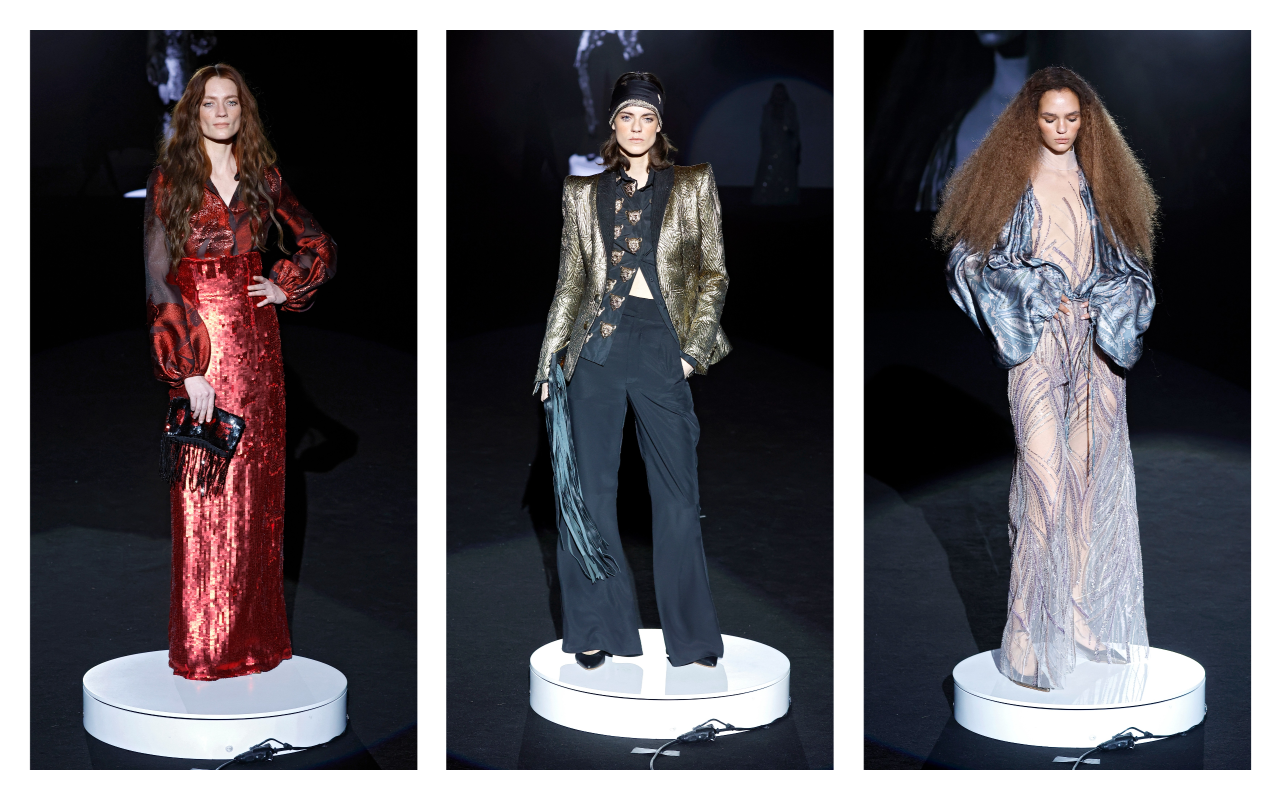 Malne. Mercedes-Benz Fashion Week Madrid. Fall/Winter 2025/2026 Collection
Malne. Mercedes-Benz Fashion Week Madrid. Fall/Winter 2025/2026 Collection
Malne
In “Bohemian Future” Malne has celebrated romantic glamour and the bohemian essence under a futuristic gaze. The firm, founded in 2016 by Paloma Álvarez and Juanjo Mánez, once again opts for slow fashion and artisanal production from its atelier in Madrid, reaffirming its commitment to sustainability and the creation of timeless pieces. With a narrative that fuses the boho chic aesthetic of the 70s with an urban and contemporary approach, the collection dresses a woman who plays with fashion without losing sight of environmental responsibility.
The key garments explore the duality between delicacy and structure: impeccably cut tweed layers are combined with fluid tunics and vaporous blouses that glide over the catwalk. The chiffon dresses, voluptuous and light, are dyed in intense colours such as emerald green, ruby red and classic black, the firm’s fetish tone. Jackets, another of Malne’s distinctive features, are presented in a fitted version, enhancing the feminine silhouette with a sophisticated and urban touch.
As for the materials, the collection for next winter is based on noble fabrics such as tweed, silk chiffon, cashmere, gazar and micropaillettes, which provide texture and subtle shine to the compositions. Each piece is designed to transmit strength and personality, reflecting the DNA of the firm and its focus on fashion as a form of artistic expression. “This collection speaks of a woman of the future, conscious and free, who does not give up luxury or the beauty of what is well done,” comment Álvarez and Mánez.
With this proposal, Malne not only reinterprets bohemian luxe, but reaffirms its place in the Spanish fashion scene as a benchmark for contemporary haute couture, where craftsmanship, sustainability and exclusivity go hand in hand to create unique and timeless garments.
 Mans. Mercedes-Benz Fashion Week Madrid. Fall/Winter 2025/2026 Collection
Mans. Mercedes-Benz Fashion Week Madrid. Fall/Winter 2025/2026 Collection
Mans
The Mans collection, winner of the L’Oréal award for the best collection at the 81st edition of Mercedes-Benz Fashion Week Madrid, delves into the reinterpretation of the feminine suit with impeccable tailoring that balances tradition and innovation. Led by Seville designer Javier Álvarez, the proposal stands out for its careful construction and attention to detail, exploring structured silhouettes with straight lines and fluid volumes that adapt to the female figure, responding to the demands of comfort and contemporary elegance.
Key pieces include British-style suits with double-breasted jackets and large lapels, combined with high-waisted, wide-leg trousers, fitted with cummerbunds and bows that add a playful touch to the ensemble. The coats, in different versions, down to the feet with rounded lapels and enveloping textures, while the shirts, both in their feminine and masculine versions, surprise with horizontal pleats and ruffle details that add a romantic air. This gender duality is also reflected in the sheer blouses and mini and midi skirts, which add versatility to the collection.
The colour palette, dominated by neutral tones, is enlivened by vibrant accents such as red, purple, yellow and orange, evoking a cosmopolitan and bold spirit. Velvet, the textile protagonist of the proposal, pays homage to the aesthetics of the 90s with Tom Ford as a reference, while Scabal wools – iconic fabrics that have dressed characters such as James Bond or Vito Corleone – provide an extra touch of sophistication and sartorial heritage.
The recognition of this collection not only celebrates the excellence of the design, but also the evolution of Mans towards a fashion that embraces diversity, functionality and contemporary luxury, always maintaining the essence of tailoring that defines its DNA. For Javier Álvarez, this award is a reward for a collection that is “difficult to build” and reflects the firm’s connection with the needs of a public that seeks special and timeless pieces.
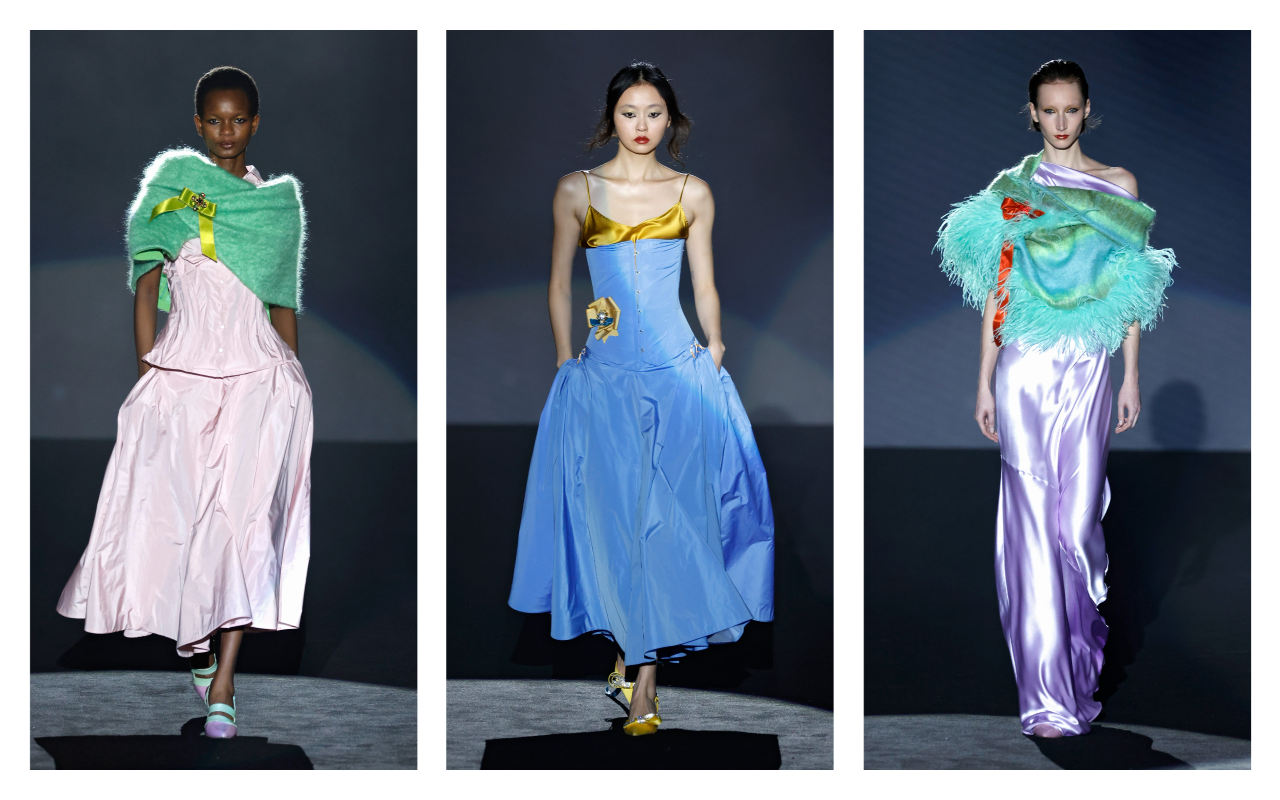 Menchen Tomas. Mercedes-Benz Fashion Week Madrid. Fall/Winter 2025/2026 Collection
Menchen Tomas. Mercedes-Benz Fashion Week Madrid. Fall/Winter 2025/2026 Collection
Menchen Tomas
BLITZ by Menchén Tomás is a collection that travels to the heart of 1980s London to revive the creative and rebellious spirit of the legendary Blitz Club. Epicenter of the underground scene and cradle of the aesthetic and musical avant-garde of the time, this legendary club inspired a proposal that celebrates freedom of expression and stylistic audacity, reinterpreted from a contemporary perspective.
For autumn-winter 2025/26, the firm led by Olga Menchén proposes pieces that invite us to play with fashion as a creative and personal act. Delicate silks, structured crepe, triacetate and chantilly make up a selection of fabrics that offer movement, texture and a feeling of tactile luxury. The colour palette evolves from the sobriety of black and white to metallic shades, eucalyptus green, porcelain blue and pale pink, evoking emotions that complement the dynamism of the garments. The silhouettes explore volumes and structures that dialogue with the aesthetic experimentation of the Blitz Club. The designs dare to decontextualise traditional garments and materials, proposing tunics, oversized blouses, straight-cut trousers and dresses that play with layers and transparencies. Each look is an invitation to break free from established norms and embrace fashion as a form of self-expression.
Beyond aesthetics, BLITZ raises a reflection on sustainability and the importance of giving materials a second life. The firm champions local craftsmanship and the value of work done in Spain, guaranteeing meticulous control of each phase of production and reaffirming its commitment to quality and environmental responsibility.
This collection, presented on the catwalk at Mercedes-Benz Fashion Week Madrid, is an ode to creative daring and free identity, where each garment seeks to inspire and empower those who wear it. For Menchén Tomás, dressing is much more than covering up: it is daring to imagine and express who we are.
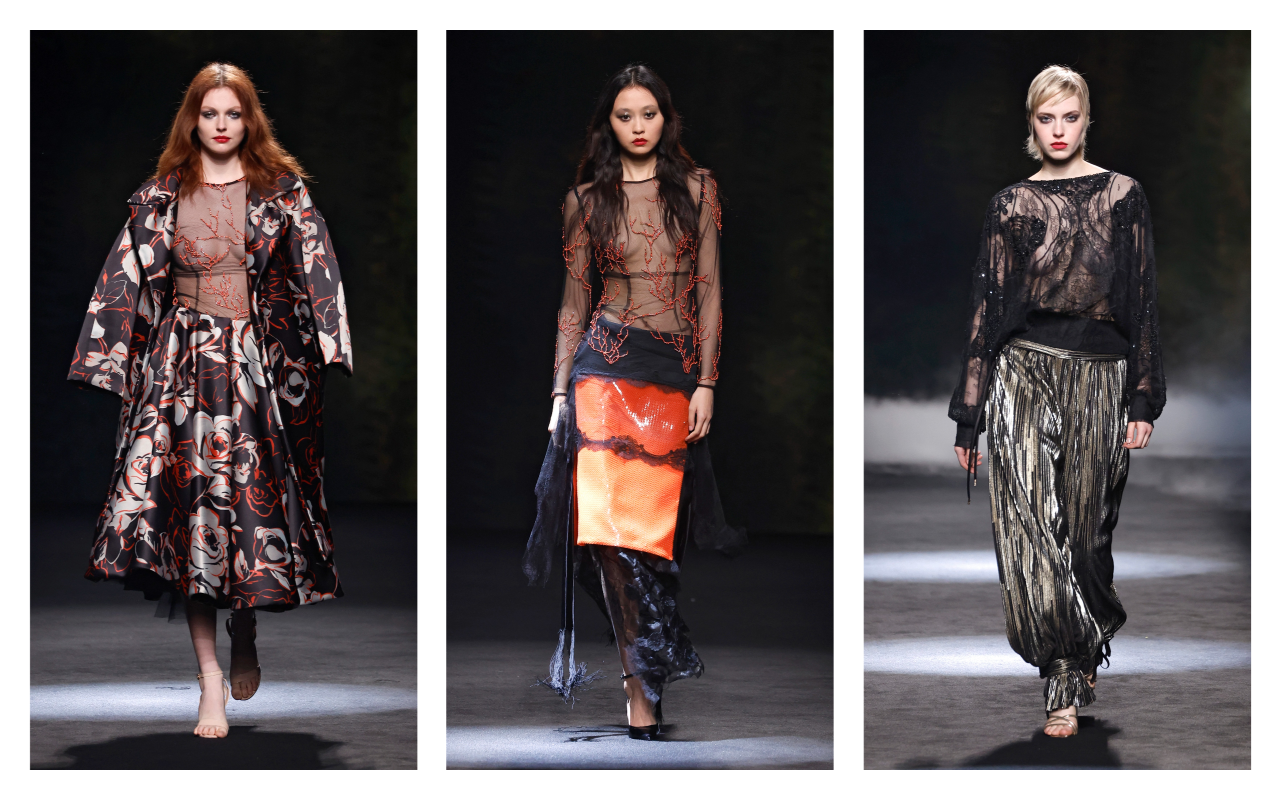 Yolancris. Mercedes-Benz Fashion Week Madrid. Fall/Winter 2025/2026 Collection
Yolancris. Mercedes-Benz Fashion Week Madrid. Fall/Winter 2025/2026 Collection
Yolancris
YOLANCRIS, the Barcelona-based label founded by sisters Yolanda and Cristina Pérez, has presented its autumn-winter 2025/26 collection under the YC ready-to-wear line: a contemporary reinterpretation of the extravagance and art de vivre of the Marchioness Luisa Casati. Inspired by this iconic figure of the 20th century, the proposal pays homage to the empowered woman who turned her life into a work of art, challenging the established norms of her time.
The collection is based on three creative pillars: Catalan Modernism, the irreverent freedom of the 1970s and the artistic heritage of Mariano Fortuny. The result is a series of pieces that explore the duality between opulence and functionality, maintaining the artisanal essence that has defined the house since 2005. Wrap-around tunics and coats are combined with 70s-style trousers and maxi blouses, while straight dresses incorporate art deco details that provide sophistication without excess.
In terms of materials, Yolancris deploys a textile universe that emphasizes quality and texture. Leather and lace — the latter worked using the soleil pleating technique — coexist with rich velvets and silk gauzes that provide lightness and movement. Artisanal embroidery and hand-made ornamental details underline the firm’s commitment to excellence in tailoring and local savoir-faire. This combination of heavy and ethereal fabrics creates a visual contrast that, at the same time, reinforces the collection’s versatility.
The colour palette ranges from dark, neutral tones—such as intense blacks and deep grays—to more vibrant accents that evoke the free spirit of the 1970s. Yolancris ‘ proposal not only seeks to dress, but also to empower: each garment is a declaration of freedom, designed for the contemporary woman who values comfort without giving up elegance.
This first foray of the YC ready-to-wear line into Mercedes-Benz Fashion Week Madrid represents an important step for the brand, reaffirming its commitment to local production and sustainability. Yolancris demonstrates that everyday fashion can be a vehicle for self-expression and authenticity, fusing tradition and modernity with a sophisticated and contemporary approach.
